Shorts Sunderland, Bluestack Mountains, January, 1944
On the morning of February 1st, 1944, Mrs Catherine McDermott,
a widow and her five young children were surprised to find two
strangers at their house door in rural Croleck (Crolack /
Cruach Leac) townland seeking assistance. It would
transpire that they were two survivors of a tragic aircraft
crash that had occured on the mountain top behind them the night
before.
This page tells the story of the tragic crash of a Royal Air Force Sunderland Flying boat that crashed in County Donegal's Blue Stack mountains in January 1944. It replaces a wonderful website created by Dyan Tucker, New Zealand, cousin of Maurice V Wareing who sadly died that night. Dyan was the driving force behind the contacting of great number of the crew's relations and the gathering of photos of the men. On her original website she had included the following acknowledgement:
I would like to thank all those
involved who have helped piece together what has been a
mystery to me for many years, particularly Dennis Burke for
his research and photos and Joe O'Loughlin for his
support and encouragement in my search, also members of the
RAF Command Message Board who have been so helpful and to
George Smith for his help also. To Paul Clarke from UTV who
has helped keep the memory alive along with the people of
the Blue Stack Mountains, the Ramblers and the good folk of
Donegal. With special thanks to Gary Pentland and all
his helpers for placing the Plaque in the Rock. Also to the
family members who have shared their stories of their loved
ones with us all and given us all extra information and
insight about that awful night.
May God bless and keep you all.
Dyan Tucker - cousin of F/O M V Wareing.
The story of the crash of Sunderland DW110 was told in the
1990's by local retired Garda, Liam Briody in a book, The
World War II Aeroplane Crash in the Blue Stack Mountains.
I have taken the liberty of linking a copy of this wonderful
resource on the webpage as it contains brilliant memories
recorded of witnesses to the crash who are now long since passed
away.
The map below has pointers placed at the crash site, McDermotts
house, the Garda Station, Straboy and Glenties, all places
mentioned in Liam's book above.
Many of those mentioned in the book above have passed away
since it was written.
Joe McDermott, the teenager who cycled with Sgt Gowans to the
Garda station passed away in 2010.
Gary Pentland passed away in 2013.
Liam Briody passed away in March of 2021 in Glenties, Donegal.
The aircraft crash site presented the survivors the unenviable
task of having to trek down the mountain in the photo below to
seek help. IN the center of the photo is Croaghanard
Lough, with the McDermott residence located at the small, dark
patch of trees just off the right center of the image, just
beyond the first plantation of trees. The view below is
looking north east from the crash site.

This is a quote from John Quinn's 1999 book "Down in a Free
State" which describes the events as described in the Irish
Armies report on the incident.
" Six Mile Climb in Sleet
The route taken by the soldiers was reported to be
approximately 6 miles of a climb on foot in foul weather of
sleet. It was early afternoon before the 15 man party,
which included stretcher bearers and a Medical Officer
arrived at the crash scene. They found the aircraft
had been broken up, not only by the impact of the crash but
also by a depth charge, which had exploded. The plane
was still on fire and unexploded bombs and depth charges lay
near the impact.
The survivors were dragged from the wreckage. The
bodies of the two pilots, Flight Lieutenant Armstrong and
Flight Lieutenant Gillingham, were still in the cockpit and
these along with the other five fatalities were removed from
the wreckage. The injured men were taken by ambulance
later that afternoon of the 1st February and handed over at
Belleck at 18.00 hours to Wing Commander Costello RAF.
Four of the seven dead were taken down with the three
badly injured survivors; leaving three more to be removed
the following day. On that night in the most awful
weather conditions, two local men from the Croagh Valley,
above which the aircraft crashed Jimmy Pete McLoone and
Paraic Owen McLoone spent the night on the mountain beside
the wreck of the ill fated aircraft "waking" the dead who
still remained there. They prayed, recited the rosary,
smoked their pipes and chatted till daybreak, thereby
ensuring, as is the custom in the area, that the dead would
not be left alone. These bodies were brought down the
following morning 2nd February 1944. The seven bodies
were laid out at the McDermott cottage before being removed
by ambulance, firstly to Finner Camp, were the formality of
registering the death within the state took place and then
to Belleck for the hand over ceremony. In the usual
manner, a military colour party under Commandant Morris
passed the bodies to the RAF under Flight Lieutenant Quail.
Meanwhile on Mullaghnadress a number of depth charges
and bombs were destroyed by Captain Gradie of the Ordnance
Corp, based at Athlone. One local man, one of many
being kept back by Military guard, watched as the tail of
the aircraft, which stood erect, was also blown up by a
small charge. The aircraft armament was dismantled and
the Brownings handed over to Commandant Morris by Captain
Teague of the Air Corp and later returned to the RAF by
Captain Moore.
About ten nights after the crash, a group of card
players returning home saw flares shooting up from the
direction of the crash site. Upon investigation they
found a couple of young lads firing Verey lights with a
substitute they had improvised in place of the normal
pistol. The young buckos were quickly sent packing from the
site."
A copy of a signal sent by 228 Squadron to various RAF and Air
Ministry offices who dealt with casualties at 1346 hours on the
2nd of February gave next of kin details of every member of the
crew as well as the survivors conditions and
locations. F/O Trull, W/O Richardson, Sgt
Hobbs were all described as seriously injured and had been
admitted to the US Armies 28th Station Hospital on the grounds
of Necarne Castle near Irvinestown. F/Sgt Gowens and Sgt
Gilchrist are described as suffering from shock and they had
been sent to the nearby RAF hospital in Necarne Castle itself.
At 10:45 on the morning of 31st January 1944, the twelve man
crew of a Royal Air Force 228 Squadron Sunderland flying boat,
serial number DW110, took off from the flying boat base at
Pembroke Dock in the west of Wales. The Squadron's
Operational Record book recorded the flight as follows:
Anti-sub. special patrol, at 1815 a/c.
acknowledged signal from Group diverting to Castle Archdale.
At 2050 gave “ETA 2330”. Nothing further heard, a/c failed
to arrive at Castle Archdale.
After some ten hours flying, the crew expected to be on the
water at Castle Archdale on Lough Erne for the night.
Another aircraft from the Squadron had left Pembroke about 8
hours prior, and it's flight record provided the weather
encountered and which were said to be same as those experienced
by DW110: Weather, cloudy,
slight rain later, cloud 10/10 1000" falling 300'.
Vis.5-10 miles deteriorating 1-2 miles, wind DW, 10mph
The Royal Air Force in the immediate aftermath of the crash put in place an investigation into the events. This was not the kind of forensic, detailed investigation that one associates with a plane crash in the 2020's. The survivors were interveiwed, and what records could be recovered from the wreckage were reviewed, along with the operational and maintenance records available at the aircraft's base at Pembroke Dock Form 765 report contained the following appended narrative report describing the crash:
The crash occurred on a very steep
slope 200 feet below the top of a 2219 feet summit, the
approximate position being lat. 54 45 15 North and long.
080430 West. The surface consisted mostly of granite and the
aircraft was apparently on South Easterly course in level
flight when it hit the mountain side bow on. It came to rest
in little more than it's own length, the wings would appear
to have carried on over the bow and the lower part of the
hull. The subsequent explosion left very little worth
salvaging.
The engine, propellors etc. were torn apart and scattered
about the wreckage except upper part of the centre section
which had carried forward with the wings. Some wireless
equipment was found in the centre section and from what it
can be gathered the fire had been kept from the centre
section and the starboard wing on account of the strong wind
prevailing, at the time.
The tail turret and the tail plane and fin had been damaged
by fire but still held together. The guns of the turret were
almost undamaged, the forward guns were seriously damaged,
and probably the galley guns will be of no further use,
these (the guns) together with the wireless equipment found
in the centre section have been held by the Eire authorities
for return eventually through normal channels.
The I.F.F. box, though damaged, was found clear of the fire
area and this together with "GEE" set, which from external
appearances, seemed to be in good condition, were taken back
to R.A.F. Castle Archdale on the 1st February.
Various papers, including intelligence folder, navigation
logs and navigation charts and W/T logs were found and
brought back to Castle Archdale. They are considerably
damaged by fire and water but most of the entries can be
read.
Four D.C's were found, they were thrown clear or the fire
area, and presumably the other D.C.'s exploded in the fire.
Before leaving the scene of the crash these 4 D.C's were
piled together with the remains of the ASV equipment and
other pyrotechnics and all detonated.
As far as be ascertained the actual time of the
crash was between 2330 and 2340 hours on the 31st January
1944. 2 watches have been recovered unidentified and
both these have stopped between 2330 and 2340 hours.
In the above text the following notes are
provided:
- I.F.F. refers to Identification Friend or
Foe equipment
- GEE refers to a radio navigation system used by the RAF
during the second world war.
- W/T refers to Wireless Telegraphy, in the context of the
use of on board radio equipment for communications and
navigation.
D.C. refers to Depth Charges
The crew this aircraft consisted of a core of men
who had trained together at 4 (Coastal) Operational Training
Unit sometime before being posted to 228 Squadron in the Autumn
of 1943. The first mission found with a majority of the
DW110 crew was on 13 August 1943 but their captains name appears
as early as mid July 1943 carrying out non operational tasks.
The back row consists of five sergeant aircrew.
Cyril Greenwood, James Gilchrist, Frederick Copp, John Parsons
and James Richardson.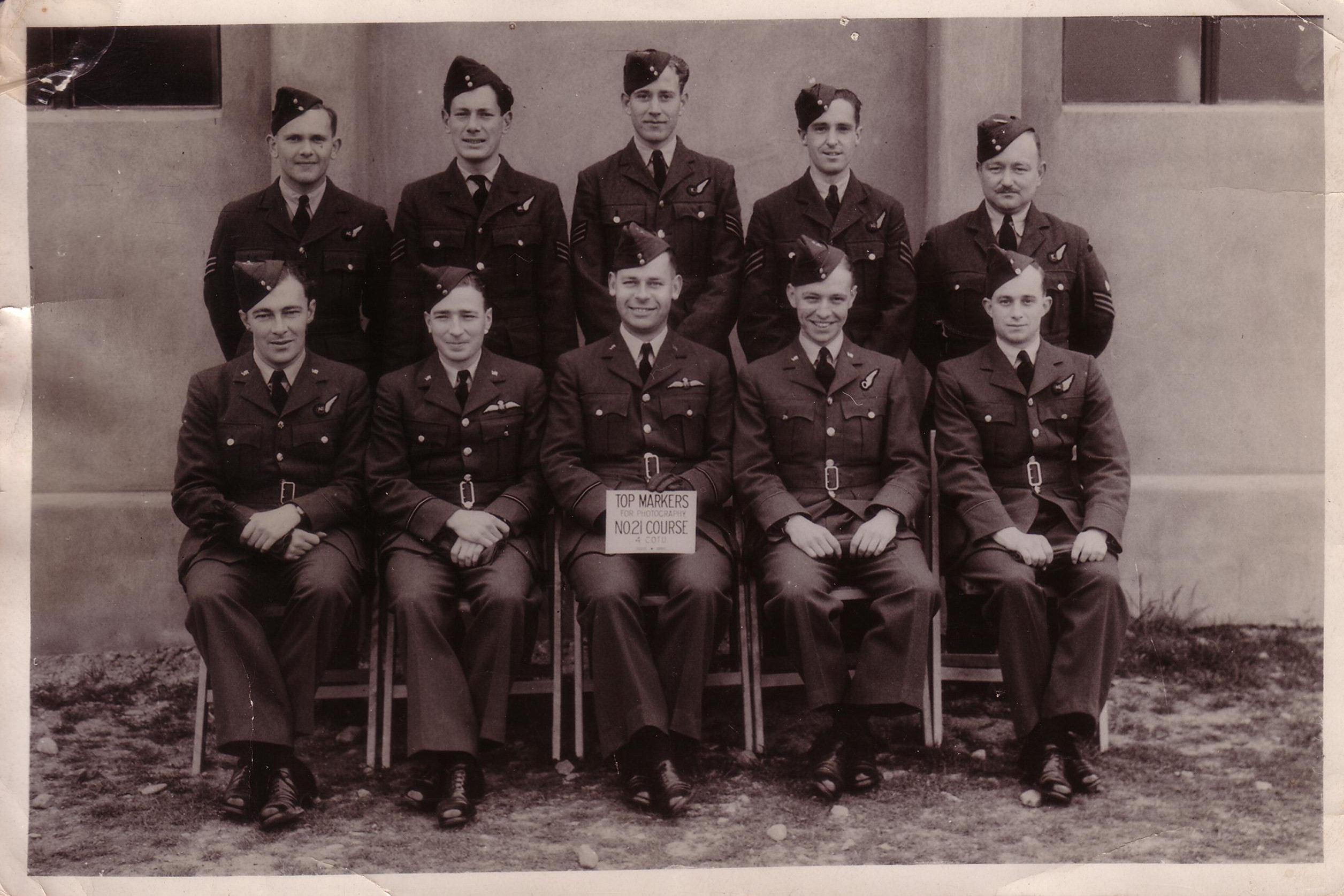
The men in the front row are all officers as evidenced by their
lack of NCO shoulder stripes and the presence of sleeve cuff
rank insignia stripes. Their trade can be identified via
the lapel badges of Pilot, observer and Air Gunner.
From left to right they are though to be:
1. A Pilot Officer (P/O) rank, Air Gunner. Name unknown.
2. A Flying Officer (F/O) rank, Pilot. This is thought to
be M V Wareing. The 228 Sqn ORB refers to him as a P/O during
August 1943 but thereafter as F/O.
3. A F/O rank, pilot. The son of F/O Alfred Thomas
HASELDINE, confirmed that his father is the officer pilot in the
center of the front row.
4. A P/O rank, Observer, who likely is Frank Trull.
5. A P/O rank, Air Gunner, identity unknown.
The early missions in the first month were flown with two air
gunner officers, P/O's A Gray and C Kelly and they are thought
to be the two men sitting at the left and right outside
positions.
F/Lt Howard Charles Sheffield ARMSTRONG DFC 42383
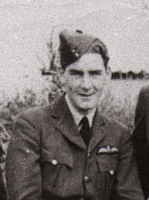 Howard was
born in 1919 in Tonbridge, Surrey, the son of Charles Sheffield
Armstrong and Catherine Myfanwy Armstrong and he is buried in
Dalston Road Cemetery, Carlisle, Cumberland. It is not
clear why he was interred there as he had grown up in the
Chislehurst area.
Howard was
born in 1919 in Tonbridge, Surrey, the son of Charles Sheffield
Armstrong and Catherine Myfanwy Armstrong and he is buried in
Dalston Road Cemetery, Carlisle, Cumberland. It is not
clear why he was interred there as he had grown up in the
Chislehurst area.
Newspapers around the UK carried his name in December 1943 when
he was awarded the Distinguished Flying Cross for the rescue
described below, but also again in April when news of his death
was reported. The Times of April 10th, 1944 reported on
his death:
Flight Lieutenant Howard Charles
Sheffield Armstrong DFC killed in action, was born in 1919
in Tonbridge. His home was at Chislehurst, Kent. Educated at
Repton School, he entered the RAF as a pupil in 1939 and was
commissioned the same year. He received the DFC in December,
1943, in recognition of his fine operational record of a
captain of aircraft with No. 228 Squadron. While on an
anti-submarine patrol in the Bay of Biscay in the previous
September he sighted two dinghies, containing survivors of
an aircraft. He reported to his base, and, obtaining the
necessary permission, landed successfully on the open sea
and rescued 12 survivors. The occupants of the dinghies had
tried to deter him from landing as there was a 30ft swell,
but in spite of this he succeeded in taking off without
incident. The whole operation was only made possible by his
admirable coolness and skill.
His local newspaper, the Bromley and West Kent Mercury in
similar articles describe him as the elder son of Mr and Mrs C S
Armstrong, and that he had attended Carn Brae preparatory
school, played for the Kent eleven and played for Bromley
Cricket Club.
F/Lt Armstrong had seen much service prior to his final flight
on DW110 in 1944. In December 1940 he was posted to the
newly formed G Flight of 119 Squadron, which had been formed to
fly the three pre-war Shorts G Class flying boats, the Golden
Fleece, Golden Hind and Golden Horn. He served at that
time with another officer, Thomas Allitt, who would be lost in
similar circumstances in July 1943 when BOAC Sunderland G-AGES
crashed on Mount Brandon, County Kerry. His winter of
1940/1941 was spent on patrols in the Golden Fleece, S.26 X8274,
and later on the other three also. As the year progressed
the flights ranged farther, with Howard flying as far as
Gibraltar on transport missions with freight and
passengers. He was posted out of G Flight on a new posting
to 413 (RCAF) Squadron.
He joined 413 Squadron on 6th September 1941 but is noted as
posted to West Africa on the 27th of that same month. He
is next found listed as part of a crew of Lerwick L7265 from 4
(C) OTU on 31st December 1941 when they suffered a landing
mishap at Invergorden, Scotland with the wing having suffered
distortion when the aircraft hit the water too hard.
The then F/O Armstrong and the three airmen were
injured but there were no fatalities. The posting to west
Africa must not have been a long one evidently. His
service from this point until his appearance in the diary of 228
Squadron in March 1943 is unknown. he flew as second pilot
to F/Lt G A Church that month before flying as a Captain in
May. It is June 1943 before Harry Holdsworth flies with
him. During June 1943, his missions are flown with a G V Harris
as co-pilot and this is discussed below in relation to the only
known photos of Howard.
He received the DFC in December, 1943, in recognition of his
fine operational record of a captain of aircraft with No. 228
Squadron. While on an anti-submarine patrol in the Bay of
Biscay on 6th September 1943 in Sunderland JM679, he sighted two
dinghies, containing survivors of an aircraft. He reported to
his base, and, obtaining the necessary permission, landed
successfully on the open sea and rescued the 12 survivors. The
occupants of the dinghies had tried to deter him from landing as
there was a 30ft swell, but in spite of this he succeeded in
taking off without incident. The whole operation was only made
possible by his admirable coolness and skill. The Squadron
ORB also records the crew finding a third dinghy with more
aircrew, and dropped them rations and markers.
This extract is taken from John Quinn's "Down in a Free State"
"The Skipper of the Sunderland DW110
was Howard Armstrong who had received his DFC for the rescue
of a Canadian Air Crew in the Bay of Biscay on the 6th
September 1943. The sea off the North Atlantic can be
turbulent and as Jim Gilchrist, who was on Armstrong's crew
that day stated "We landed in the trough of the huge rolling
swell for which the Bay of Biscay is renowned and
managed to rescue all twelve young men, Our take off was
breathtaking"
He paid tribute to Armstrong for skill and daring in an
Epic rescue."
Another extract from
the same book.
Don Wells from Canada one of the
rescued that day tells about the rescue.
"A wing came up and we were afraid it was too tough to
attempt a landing. We tried to wave him off but
the pilot found the right trough and dropped it like a
real pro. We were all rather weak after three days of
soaking in salt water and had to be helped into the
aircraft. I was given a cup of tea and place in
the bomb bay with my back to the wall. The take-off was
awesome, we were sure the aircraft would come apart but
the pilot finally got it into the air and set course for
home.
The flight was not entirely uneventful as we came a bit
close to Brest (it was dark at that time) and the
Anti-aircraft gunners had a go at us. Not too long
after we were landing at Pembroke Dock. The
aircraft was out of fuel and the tide was out as
well. After an interminable wait we were towed to
the pier and managed to climb to the top of a lot of
steps and walk a very long way to dry land."
The squadron ORB lists the crew on the day of the rescue as F/Lt.
Armstrong, F/Lt Majendie, F/O Wareing, F/O
Trull, F/O Kelly, F/S Richardson, Sgt Copp,
Sgt Parsons, Sgt Greenwood, F/S Robey, W/O
Holdsworth, Sgt Gilchrist. Thus, eight of those on
board were also on the final flight of DW110
In 1952, a newspaper memorial was published on 16
February: ARMSTRONG, Howard C.
S. Flt. Lt., D.F.C. - To the glorious memory on this his
birthday. per Ardua ad astra. - Mother, Father and
John.
His brother, John
Albert Sheffield Armstrong, died in September 2000 in Exeter
but sadly his family records appear to have been lost.
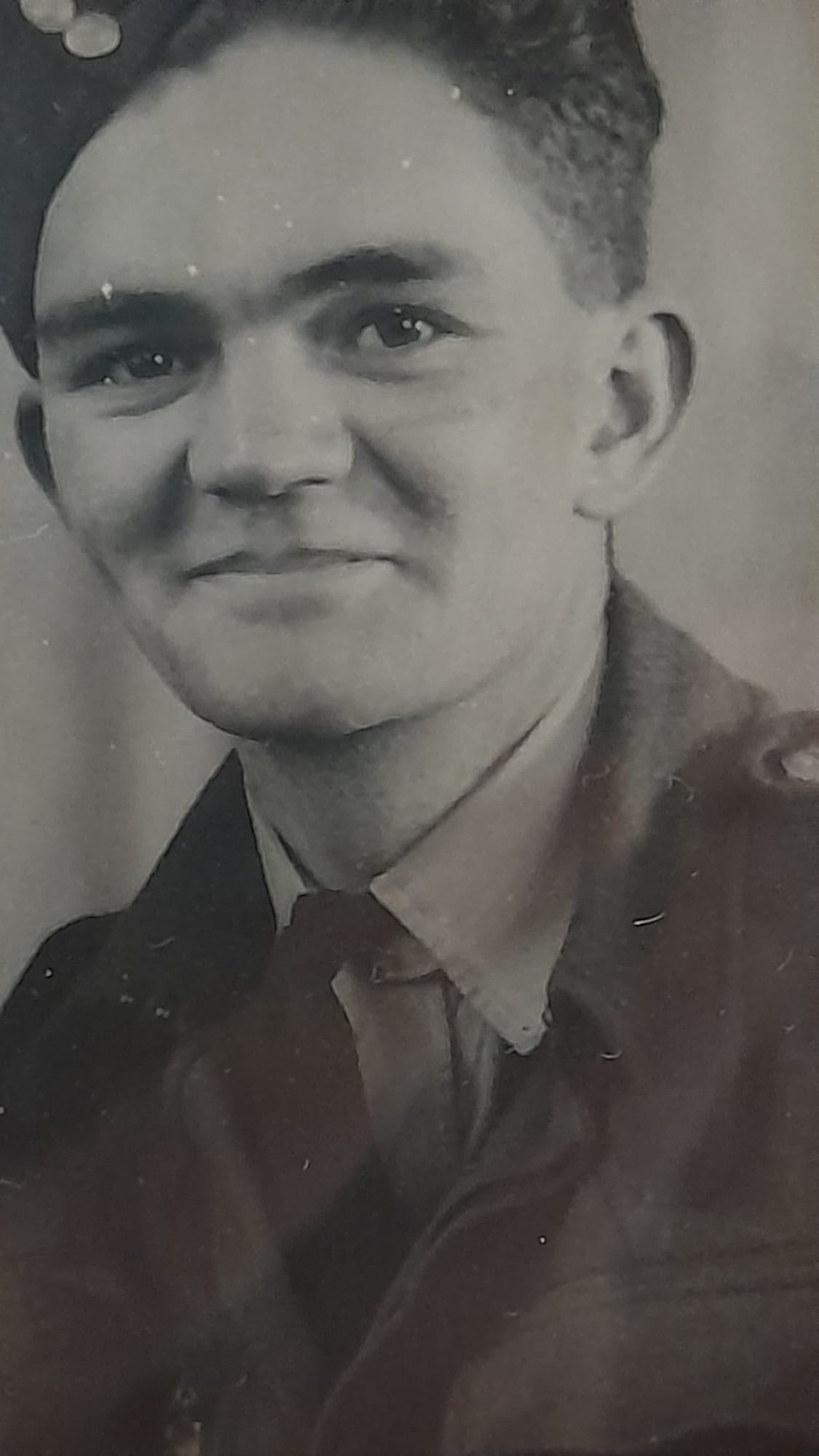 The photo of F/Lt Armstrong comes from a
photo printed in John Quinn's Down in a Free State. It
is credited as coming from Harry Holdsworth, who we found
mentioned in Liam Briody's book and who hailed from Bangor
in Northern Ireland. The book only identifies F/Lt
Armstrong (Back Row, second from left) and Harry (front row,
first man at left). The other nine men are not
identified. It is noted that there are three crew
members with pilot wings, the man to the left of Howard
Armstrong and the fourth man from the left at the front, a
Sergeant pilot. The man standing at the rear most
right has the chest insignia of an Observer
(navigator). The uniform of the pilot next to
Armstrong is darker than the others and indicates that he
may have been Royal Australian Air Force.
Frustratingly, 228 Squadron's ORB does not identify
Commonwealth airmen in the way many others do. It was
thought that this might be a photo of the crew of Sunderland
JM679
after the rescue of September 9, 1943 but on that occasion
all the pilots were officers (F/Lt. Armstrong, F/Lt
Majendie, F/O Wareing) and none were Australian. By
pure chance, it was possible to determine that the dark
uniformed pilot in the photo is most likely Gifford Valmyn
Harris AUS401505, who went onto captain his own crew in July
1943. Similarly, the Sergeant Pilot in the front row,
appears to be a Dutch man in the RAF, Antonius J
Mussert. One might reasonably time the photo as being
in June 1943 based on this.
The photo of F/Lt Armstrong comes from a
photo printed in John Quinn's Down in a Free State. It
is credited as coming from Harry Holdsworth, who we found
mentioned in Liam Briody's book and who hailed from Bangor
in Northern Ireland. The book only identifies F/Lt
Armstrong (Back Row, second from left) and Harry (front row,
first man at left). The other nine men are not
identified. It is noted that there are three crew
members with pilot wings, the man to the left of Howard
Armstrong and the fourth man from the left at the front, a
Sergeant pilot. The man standing at the rear most
right has the chest insignia of an Observer
(navigator). The uniform of the pilot next to
Armstrong is darker than the others and indicates that he
may have been Royal Australian Air Force.
Frustratingly, 228 Squadron's ORB does not identify
Commonwealth airmen in the way many others do. It was
thought that this might be a photo of the crew of Sunderland
JM679
after the rescue of September 9, 1943 but on that occasion
all the pilots were officers (F/Lt. Armstrong, F/Lt
Majendie, F/O Wareing) and none were Australian. By
pure chance, it was possible to determine that the dark
uniformed pilot in the photo is most likely Gifford Valmyn
Harris AUS401505, who went onto captain his own crew in July
1943. Similarly, the Sergeant Pilot in the front row,
appears to be a Dutch man in the RAF, Antonius J
Mussert. One might reasonably time the photo as being
in June 1943 based on this.
Harry Holdsworth is pictured here in a photo provided by his
niece.
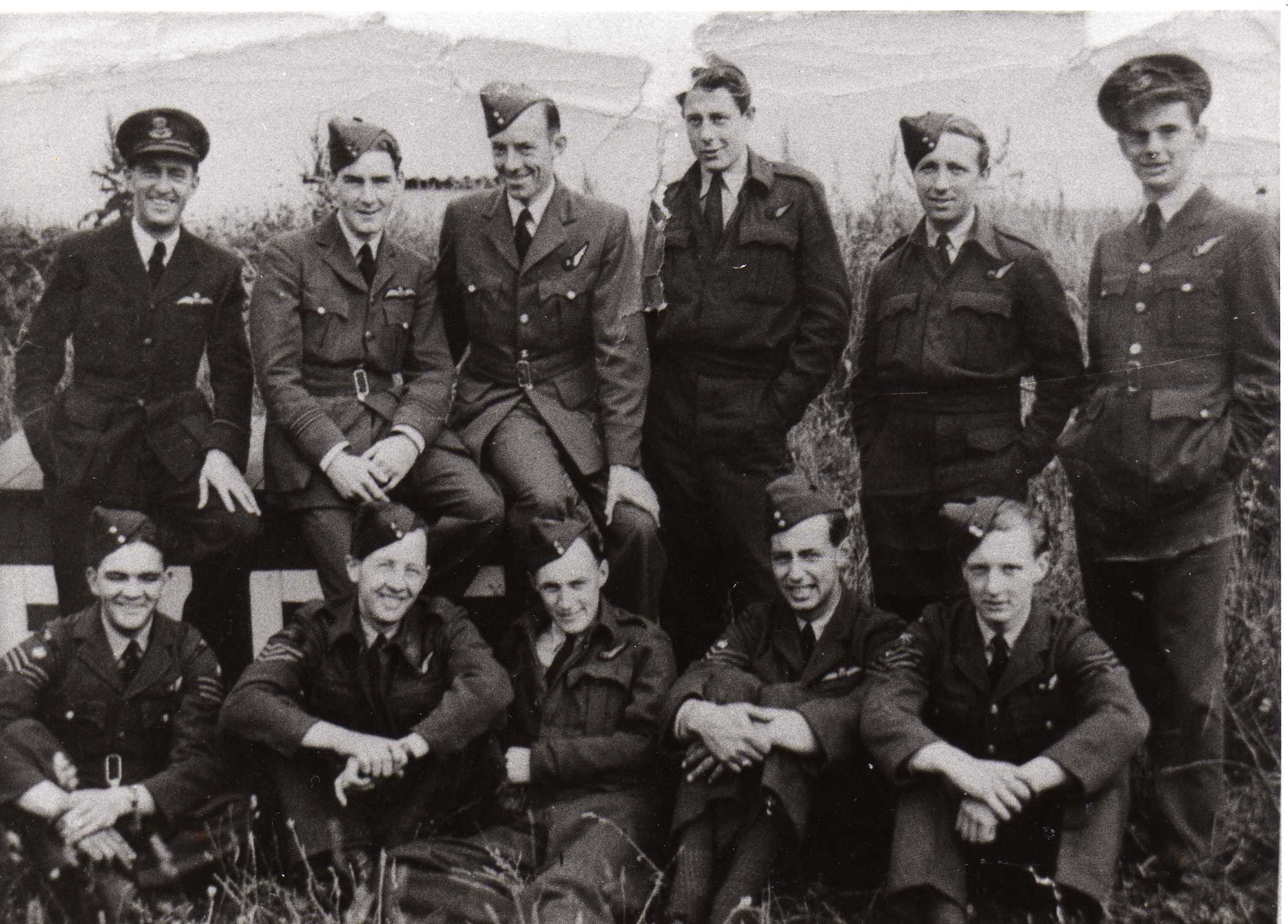
F/O Maurice Vincent WAREING 129072
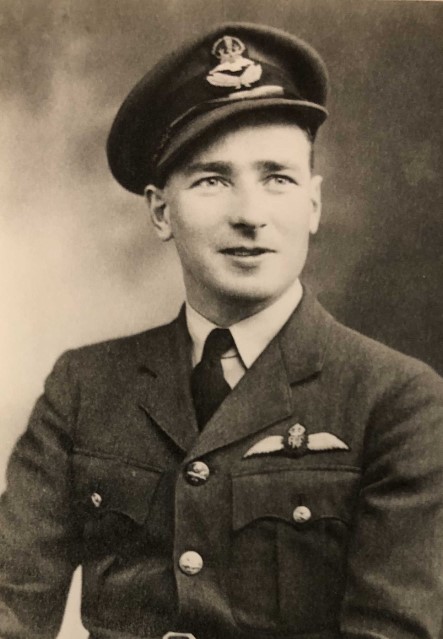 Maurice was
born in July 1916, the fifth son of Jane and Charles Wareing in
Birmingham. Maurice can be found residing with his
parents and four of them at 192 Gravelly Hill in Birmingham in
the 1939 register. One brother, Gerard, died only a month
later.
Maurice was
born in July 1916, the fifth son of Jane and Charles Wareing in
Birmingham. Maurice can be found residing with his
parents and four of them at 192 Gravelly Hill in Birmingham in
the 1939 register. One brother, Gerard, died only a month
later.
Vince as he was known to the family or Vic in the RAF was born
in July of 1916, . Prior to his enlisting he owned a
Garage in Erdington with his brother Robert. 1939 he
married Joyce Robertson and they had a daughter, Teresa, who was
born in 1940.
He went to the USA for flight training at the US Naval Air
Station, Grosse Ile, in Michigan in 1941 - went via ship to
Canada then flew from Toronto. He was involved in the rescue of
the downed crew for which F/Lt Armstrong got his D.F.C.
Vince joined the RAF at the outbreak of War, according to the
accident report he had done just over 530 hours flying time in
Sunderland flying boats but only 9 hours night flying, which
would perhaps account for the fact that Armstrong and Gillingham
who had greater night time hours were in control of the aircraft
at the time of the crash.
Vince is buried with his two brothers, Charles and Robert, at
Erdington Abbey, Birmingham.
In 2024 his grandson and great grandsons embarked on a mission
to learn more about Vince who had been so sadly lost in
1944. This resulted in being able to visit his grave for
the first time and receiving his service record and his war
medals.
From left to right they are the: 1939-45 Star, Atlantic
Star, War Medal 1939-45

F/Lt Maurice Leonard GILLINGHAM 104369
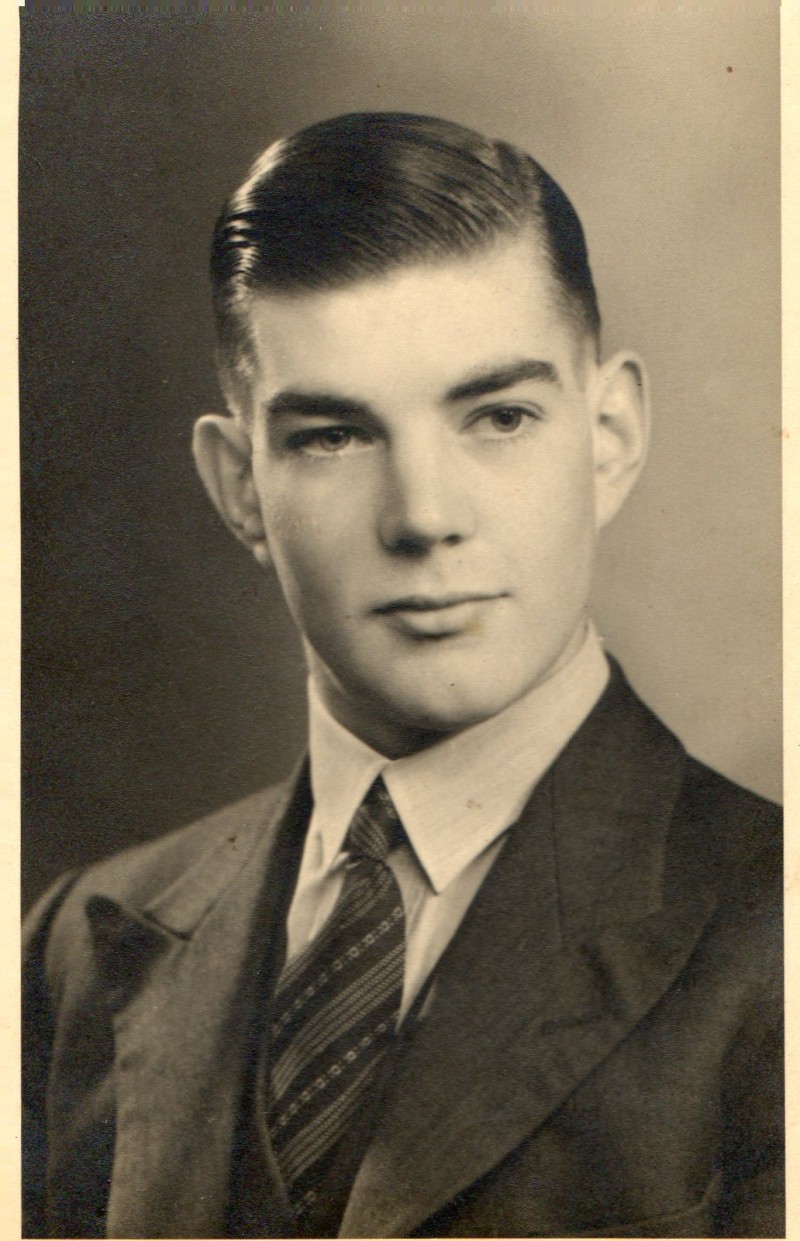 Son of
Frederick Morris Gillingham and Florence Matilda Gillingham of
Surbiton, Surrey. He was known within the family as Peter.
Son of
Frederick Morris Gillingham and Florence Matilda Gillingham of
Surbiton, Surrey. He was known within the family as Peter.
His name can be found in the Squadron records of 38 Squadron
between January 1942 and February 1943. At that time, 38
Squadron were based in Middle East flying Vickers Wellington
Bombers on anti shipping missions and later returning to bombing
raids on Axis targets.
His posting into 28 Squadron is not clear, it is not recorded
in the Summary of Events but his name appears on operational
flights with with the crew of F/O J Quinn on the 19th and 21st
of January before joining F/Lt Armstrong for missions on the
29th and the fatal mission of the 31st January. A clue
perhaps is in the casualty telegrams found in F/Sgt Green's RCAF
service file where M L Gillingham is labeled as "Unit 4(C) OTU"
suggesting that perhaps he was on temporary posting to the
Squadron or that paper work had not followed up with him, such
that on paper he was still on the strength of No 4 Coastal
Operational Training Unit.
He was buried at Irvinestown Church of Ireland Churchyard, his
father attended the funeral and his mother died a year later.
One of his sisters, Joan, was the principal Mezzo-soprano with
D'Oyley Carte Opera Company from 1946 to 1958 and made
several recordings. Prior to joining D'Oyley Carte she was
with the WAAF Concert Party. She died at the age of 42 of
cancer in 1958.
Another interesting fact came to light during research into the
crew - Maurice Gillingham's father was born Frederick Morris
Guggenheim, he changed his name by Deed Poll in June 1920 to
Gillingham. In the London Gazette it states that Frederick
Morris Guggenheim was a watch and clock importer.
Peter and his parents in 1941 and in shorts in the middle east.
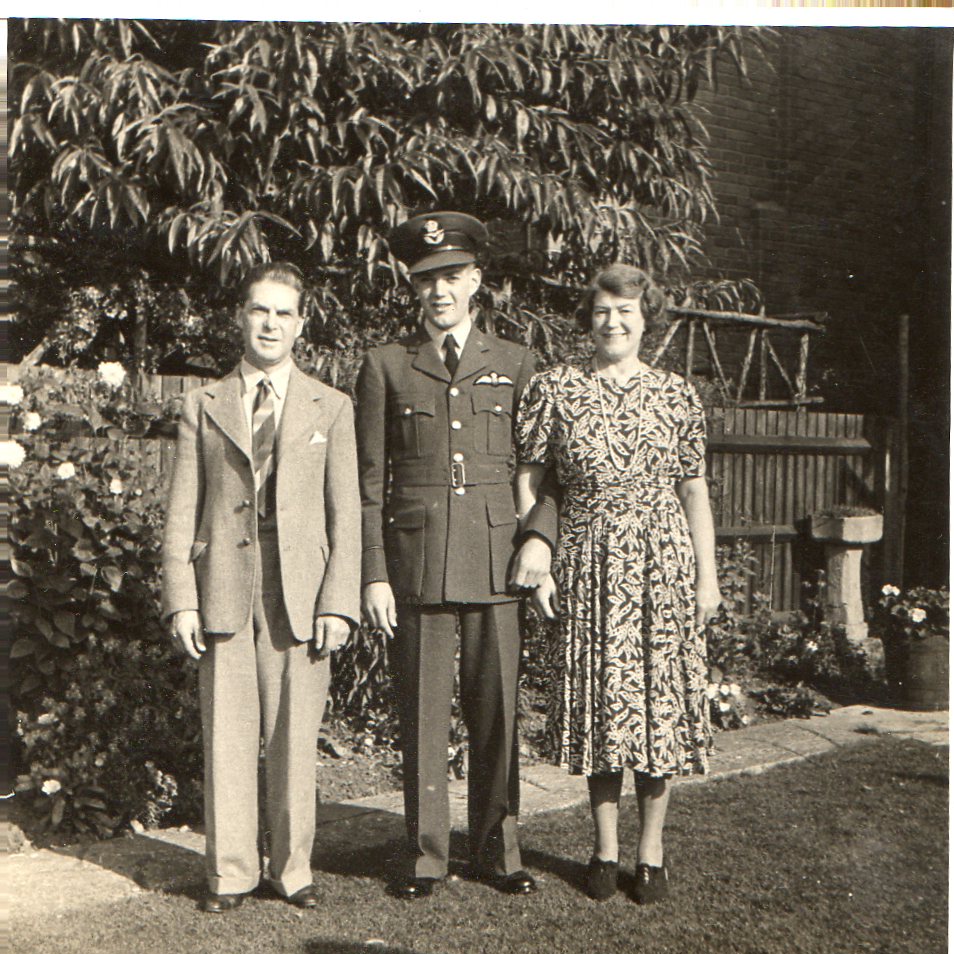
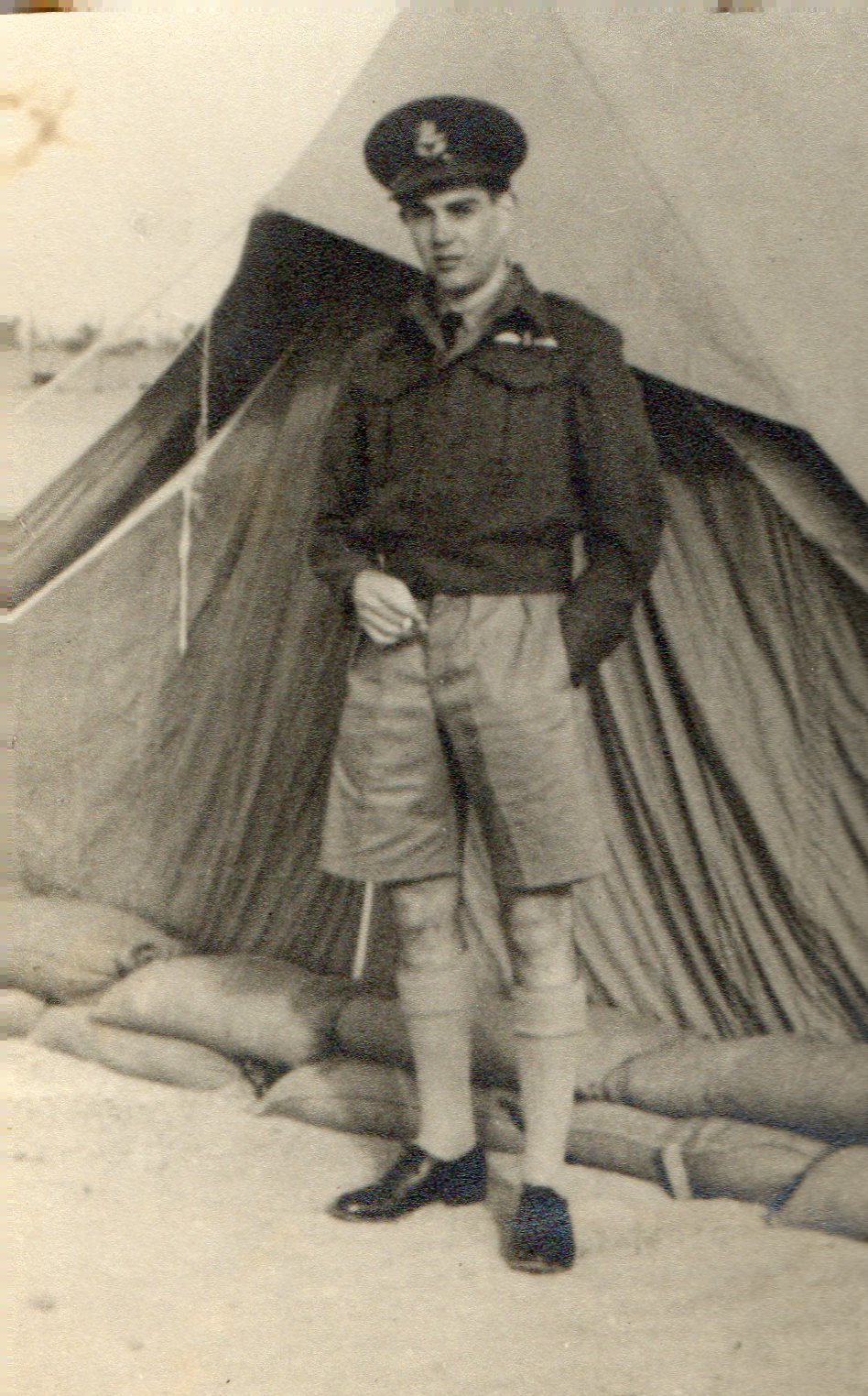
F/O Joseph George TRULL 128117
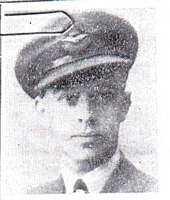 He was the son of Gnr
Joseph Charles Trull Royal Garrison Artillery (killed in action
in France 9th April 1918) and Bessie Trull of Uley,
Gloucestshire.
He was the son of Gnr
Joseph Charles Trull Royal Garrison Artillery (killed in action
in France 9th April 1918) and Bessie Trull of Uley,
Gloucestshire.
His crossing of the border into the United States is found in
October 1941 on his way to attend training at Maxwell Field,
Alabama.
He survived the crash of DW110 but was killed, later that year,
on 11 December 1944 when flying in Sunderland ML878. The
crew were diverted to land at Mount Batton again, due to weather
being so bad at Pembroke Dock. The aircraft crashed on
landing with Joseph and another crew member being drowned. He
was 27. According to reports J.B. Richardson attended his
funeral along with other members of 228 Squadron.
Obituary
FLT LIEUT. J. G. TRULL, R.A.F., AT ULEY.
Much sympathy has been aroused at Uley and Dursley by
the death of Flight-Lieut. J. G. Trull, R.A.F., 228
Squadron, son of Mrs. J. Trull, South Street, Uley, who was
killed on operational duties. Flt-Lieut. Trull was educated
at Dursley Secondary School, on leaving which he was
employed in the drawing office of Messers. R. A. Lister and
Co., Ltd. He joined the Home Guard on its inception and in
1941 he volunteered for the Royal Air Force. After
preliminary training in this country he went to Canada and
the United States, where he was awarded his commission. He
was the possessor of National Certificates in both
electrical and mechanical engineering. Flt.-Lieut. Trull had
arranged to Marry Miss H. P. Akers early next year, and the
banns of their marriage were called on the Sunday previous
to his death. His father died in the service of his country
in the last war and his brother, Pilot Officer Trull, is
also serving in the RAF.
There was a large attendance at the funeral, which took
place at St. Giles Church, Uley, conducted by the Rev. T. C.
Deakin, the choir leading the singing and Hymns.
He was returned home and is buried in St Giles Churchyard,
Uley, Gloucestershire
W/O John Bruce RICHARDSON 523921
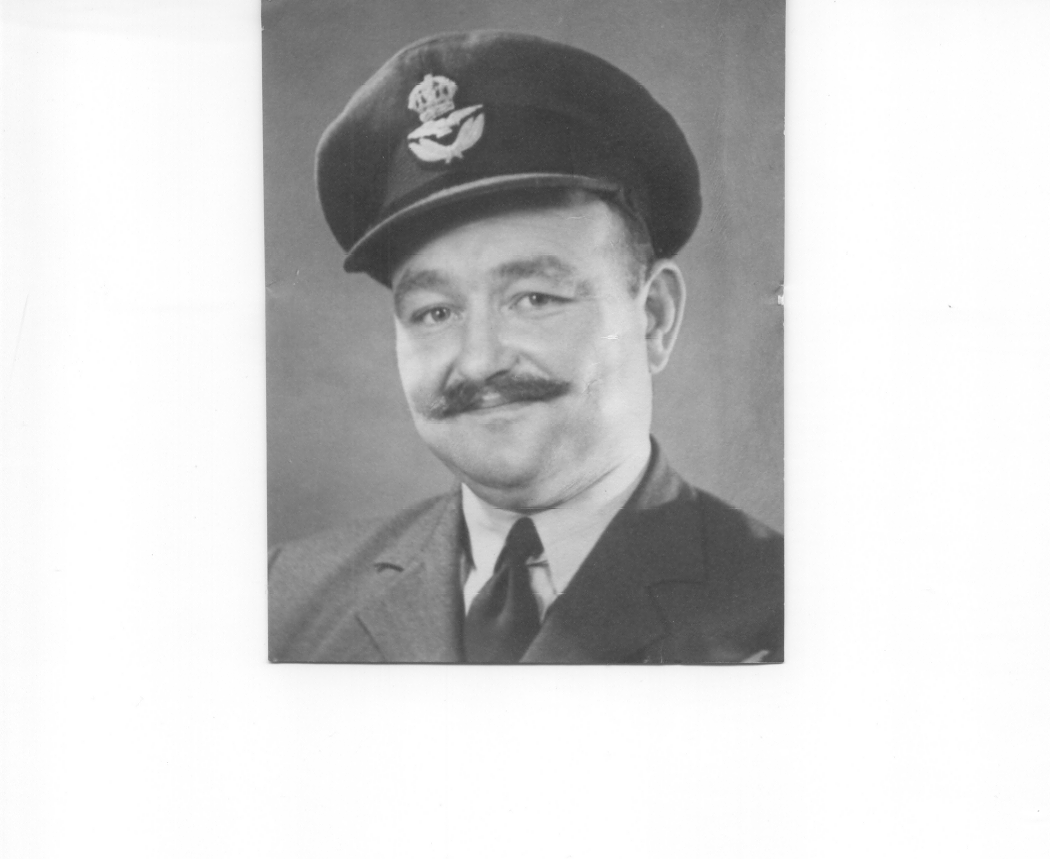 John Bruce
"Tubby" Richardson was born in 1915, the son of Ernest Albert
and Marie Ernestine Richardson, of Saltash, Cornwall and came
from a family of 5. His father was involved with the Devonport
Naval Dockyard. One of his brothers, Sergeant Christopher Arthur
Richardson, 51 Squadron, was killed in the war and is
buried in Holland, other family members also served in the
Forces as described below.
John Bruce
"Tubby" Richardson was born in 1915, the son of Ernest Albert
and Marie Ernestine Richardson, of Saltash, Cornwall and came
from a family of 5. His father was involved with the Devonport
Naval Dockyard. One of his brothers, Sergeant Christopher Arthur
Richardson, 51 Squadron, was killed in the war and is
buried in Holland, other family members also served in the
Forces as described below.
Photo taken after the crash in 1944 he was a F/O by then.
John Bruce Richardson was a Flight Engineer who completed 3
tours of Operations on Sunderland Flying Boats and then flew 310
sorties during the Berlin Airlift. His log books covering
the period 12 October 1936 to 19 May 1958 record over 6,752
flying hours.
Flt Richardson was a pre-war RAF regular LAC Engineer, he took
his first flight on the 12 October 1936 with 204 Squadron.
He qualified as an Air Gunner and at the outbreak of WW2 was
flying with 204 Squadron operating Sunderland Flying Boats with
his first anti Submarine patrol taking place on the 8th
September 1939. His log books record anti submarine
patrols, convoy escorts, flights to Gibraltar etc. During 1943
he re-mustered to a Flight Engineer and returned to operations
with Coastal Command on Sunderlands. John returned to
operations on the 20th June 1944. His last war flight was on the
10th May 1945 when on patrol they spotted and escorted a U
Boat. Remaining with the RAF he converted to the Avro York
and took part in 310 sorties during the Berlin Air lift, his
logs show a regular cargo of potatoes and coal. Various
operational postings followed and in early 1952 he joined the
Armament and Guided Weapons Flight at Farnborough and took part
in Guided Missile and NBC Tests. His last flights were
with 24 Squadron during 1958. Much of the above biography
is taken from an old Bosleys Auctioneers Catalogue when his Log
books, medals and uniform were auctioned in 2007.
John was awarded the Distinguished Flying Cross (D.F.C.), the announcement appeared in the London Gazette on the 27th July 1945 while he was still serving with 228 Squadron. That notification did not carry a citation but the UK National Archives reveal that it was awarded for valuable services in the air with the following recommendation citation: This officer has had an exceptionally long and arduous flying career. After completing two tours and also after being involved in a serious crash, he volunteered for a third tour of duty. As a flight engineer his coolness and resolution have been of great value to his crew, particularly during moments of stress. Flying Officer Richardson has always set an outstanding example.
The Cornish Guardian newspaper printed a longer article on 2nd August 1945.
SALTASH AIRMAN WINS D.F.C.
FAMILY'S FINE RECORD
Among West Country recipients of recent awards is John
Bruce Richardson, R.A.F., second son of Mr. and Mrs. E. A.
Richardson. of Mounty Tavy, Home Park Road, Saltash, who has
been awarded the D.F.C. The citation states: "This officer
has had an exceptionally long and arduous flying career.
After completing two tours and being involved in a serious
crash, he volunteered for a third tour of duty. As a
flight-engineer, his coolness and resolution have been of
great value to his crew particularly in moments of stress.
Flying Officer Richardson has always set an outstanding
example."
Flyg-Off. Richardson, who is 30, was
educated at the Corporation Grammar School, Hyde Park School,
Plymouth and Tavistock Grammar School. He enlisted in 1935 and
was commissioned in 1944. He is a rugby enthusiast
and played for Plymouth Albion Juniors. Richardson's family
have a record to be proud of in the war effort. His elder
brother. Com. Eric Nelson Richardson, R.N. is one of the
youngest of his rank in the navy, and another brother, Peter
George, is a captain in the Royal Engineers.
His eldest sister, Elizabeth, is
serving with a Red Cross ambulance in Belgium, and his
youngest sister, Christine Mary, has been in the Women's
Land Army service since the beginning of the war.
Her twin brother, Sergt.-Navigator
Christopher A. Richardson, R.A.F., was killed on May 26,
1943, while flying over Germany.
John died in April 1982 in Saltash, Devon.
Sgt Charles Stanley HOBBS 1644857
Charles Hobbs was the one crew member that little was learned
about. His service number 1644857, indicated he enlisted
sometime on or after October 1941 at Cardington,
Bedfordhire. He was listed on the crew list as FME/AG, a
flight mechanic engines/air gunner.
His next of kin is listed as Ethel Hobbs at 37 Kelvin Road,
Islington. That address reveals Stanley was resident there
at the time of the 1939 register and working as a "General metal worker and filer (Heavy
worker)". He and Ethel had married in 1934
in the Finbury district, their marriage certificate recording
his parents were Florence and Charles Alfred Hobbs. His
father is listed as a silversmith on the marriage certificate
and at the time of his father's death, the probate record listed
"Charles Stanley Hobbs, silversmith" as his next of next of kin.
Charles is described as seriously injured in crash in casualty
notices but survived. He had enlisted in the RAF on the
30th of September 1942. The first half of 1943 were spent
training at Number 5 School of Technical Training and number 1
Air Gunnery School. June and most of July 1943 finds him
posted to No.s 4 and 132 Operational Training Units before he is
posted into 228 Squadron on 29 July, but then immediately posted
to 201 Squadron on the same date. The following three
months are a mix of assignments to RAF Great Orton, to 6 (C)
OTU, 201 Squadron and RAF Aldergrove until he is posted back to
228 Squadron on the 20th of October 1943 where he served until
the crash described here. He flew his first combat patrol
on the 7th of December with F/O R S Smith. His first
mission with F/Lt Armstrong was on the 14th December 1943, and
he flew with him on his next three, the last being the night of
the crash.
His service record, obtained in 2024 with a lot of privacy
redaction, has his occupation redacted. Almost all
postings listed after the crash are redacted which likely
indicates that they reflect hospitalizations, or medical care
postings. The only posting that is left readable is to PHU
Morecambe, a reference perhaps to the Midland Hotel in the town
of Morecambe, Lancashire which was used a hospital. The
PHU was a Personnel Holding Unit and was one of the many RAF
administrative posting and may indicate he was posted to
accommodation in the town, not to the hospital itself. His
discharge from the forces came finally on the 23rd of August
1946.
He passed away in Islington, London, on 22nd November
1990. His ashes were scattered in 1991 at the East
Finchley Crematorium. In 1999, his second wife Bessie (nee
Rowe) died and her ashes were scattered also.
Sgt Cyril Robinson GREENWOOD 1129218
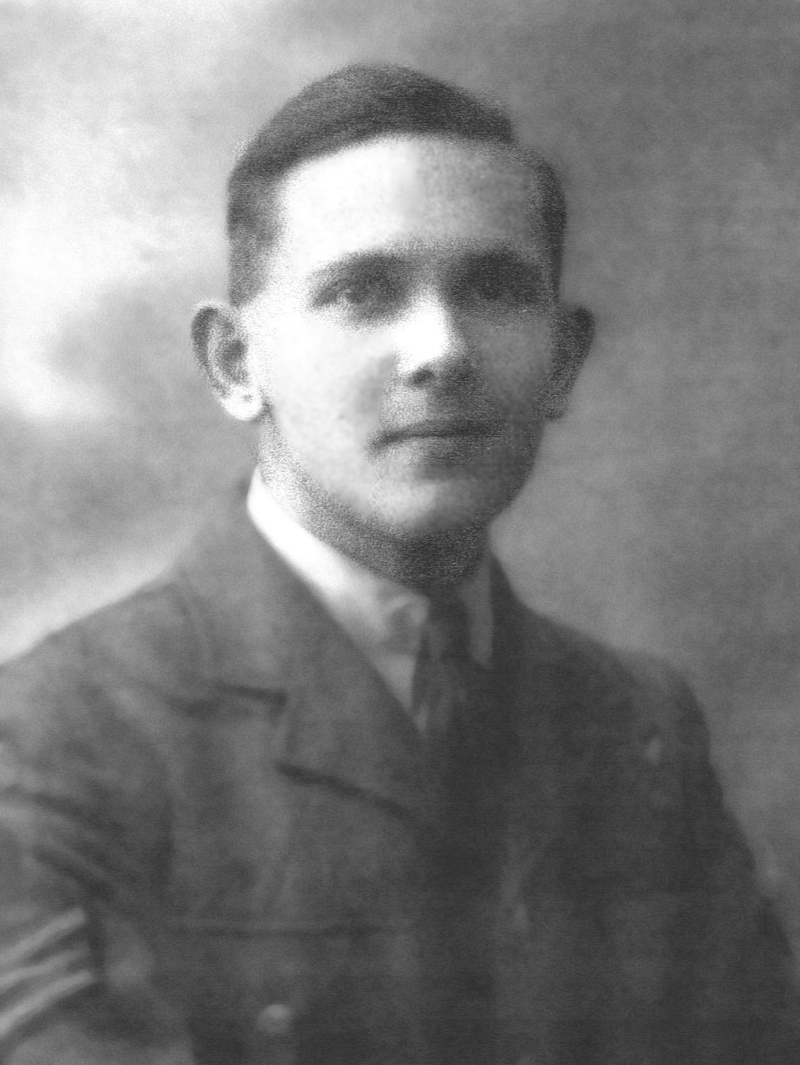 Son of
Frederick Robinson Greenwood and Winifred Greenwood of
Irlams-O'-th-Height, Salford.
Son of
Frederick Robinson Greenwood and Winifred Greenwood of
Irlams-O'-th-Height, Salford.
Cyril died on 1st of February from his injuries approximately
12 hours after the crash, he was 21. He was known to his
family as Pat and to his crew mates as "Paddy"
His brother was serving in the Army in the Burma Campaign
at the time and he wanted to transfer to be together. His
brother survived the war.
Buried at Pendlebury, St John Churchyard, Salford on 9 Feb 1944,
his headstone was erected on Easter Sunday 1950. As late
as 1956, one can find that his family would publish a memorium
notice in the Manchester Evening News.
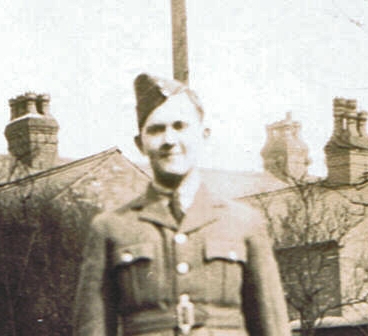
F/Sgt Frederick George GREEN R/184005 RCAF
 Fred Green was born in
1912 to Margaret and John Green in Billings, Ontario. He
worked vairous roles before the war, his last being as a
miner. he and Teresa married in July 1940. He
trained as a Wireless Operator and Air Gunner in the Bahama's
and Quebec with the RCAF before going to the UK to join up with
the RAF. This was his first flight with the "Armstrong Crew", he
replaced W/O Harold Holdsworth who was hospitalized with a
throat infection. Indeed, he was only shown to be posted
into 228 Squadron on 25 January 1944.
Fred Green was born in
1912 to Margaret and John Green in Billings, Ontario. He
worked vairous roles before the war, his last being as a
miner. he and Teresa married in July 1940. He
trained as a Wireless Operator and Air Gunner in the Bahama's
and Quebec with the RCAF before going to the UK to join up with
the RAF. This was his first flight with the "Armstrong Crew", he
replaced W/O Harold Holdsworth who was hospitalized with a
throat infection. Indeed, he was only shown to be posted
into 228 Squadron on 25 January 1944.
The commander of 228 Squadron wrote to Fred's mother after the crash to provide details of his funeral to her. He confirmed that F/Sgt Gowens and Sgt . Gilchrist were in attendance at his funeral. He was buried at Irvinestown Church of Ireland Churchyard.
Carol was able to provide the following photos of the funeral
of her father and his two comrades, provided to her mother at
the time by the air ministry.
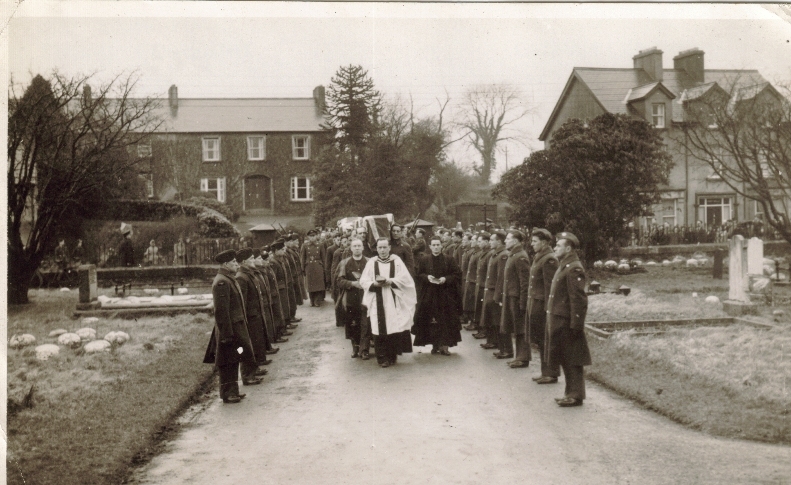
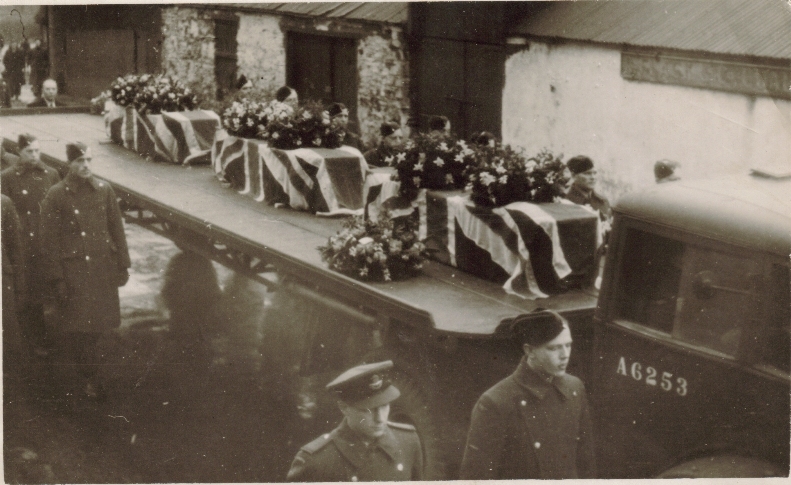
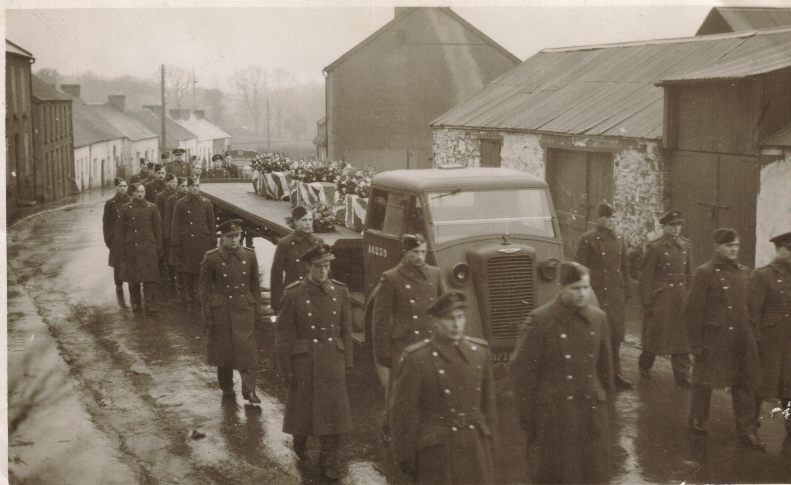
Sgt John Ernest PARSONS 1315937
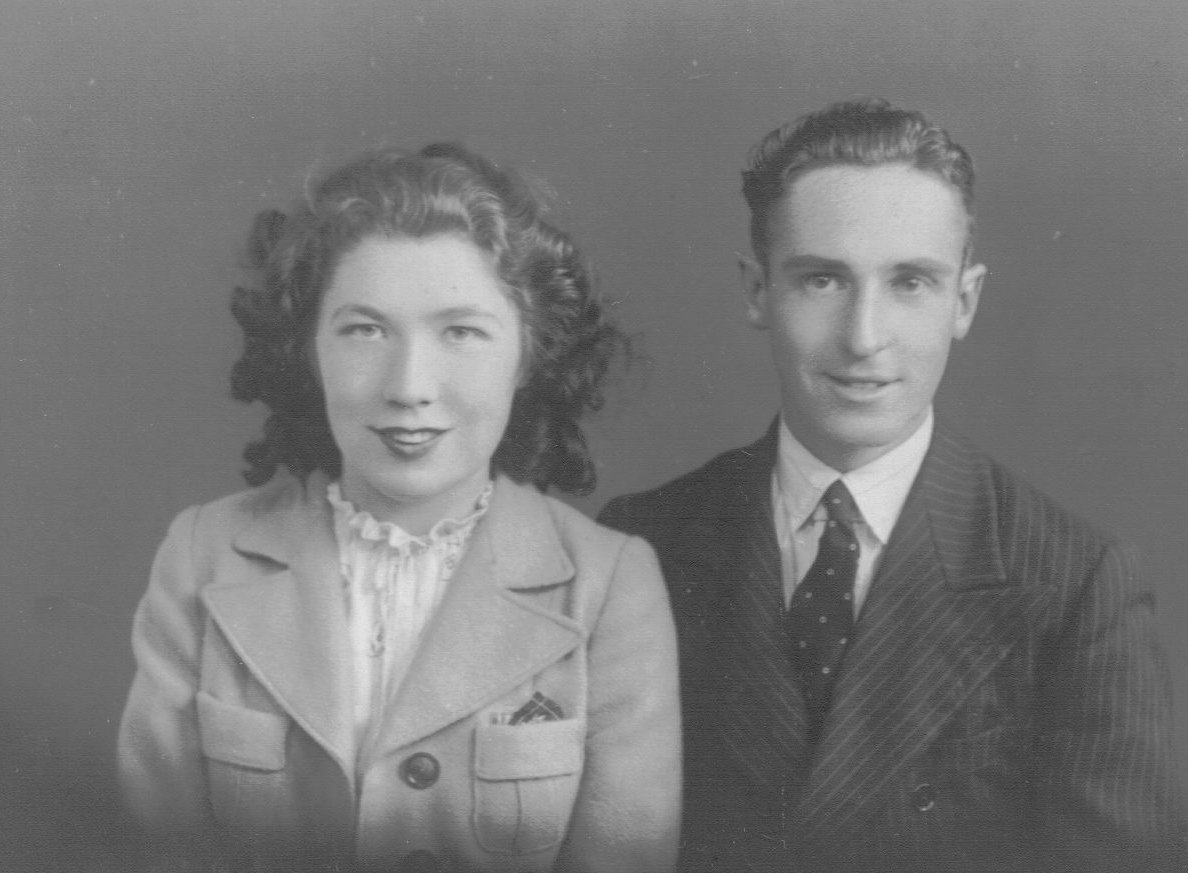 Son of Ernest and Ethel
Parsons of Yatton and husband of Peggy Doreen Mary Parsons of
Keynsham. He was born on the 21st march 1921 and was
married to Peggy in late 1942.
Son of Ernest and Ethel
Parsons of Yatton and husband of Peggy Doreen Mary Parsons of
Keynsham. He was born on the 21st march 1921 and was
married to Peggy in late 1942.
He was Buried Keynsham Cemetry.
Peggy remarried after the war and her daughter very kindly
provided the photos shown of John and Peggy.
The Wiltshire and Trowbridge Advertiser on February 12th 1944
carried the following death notice:
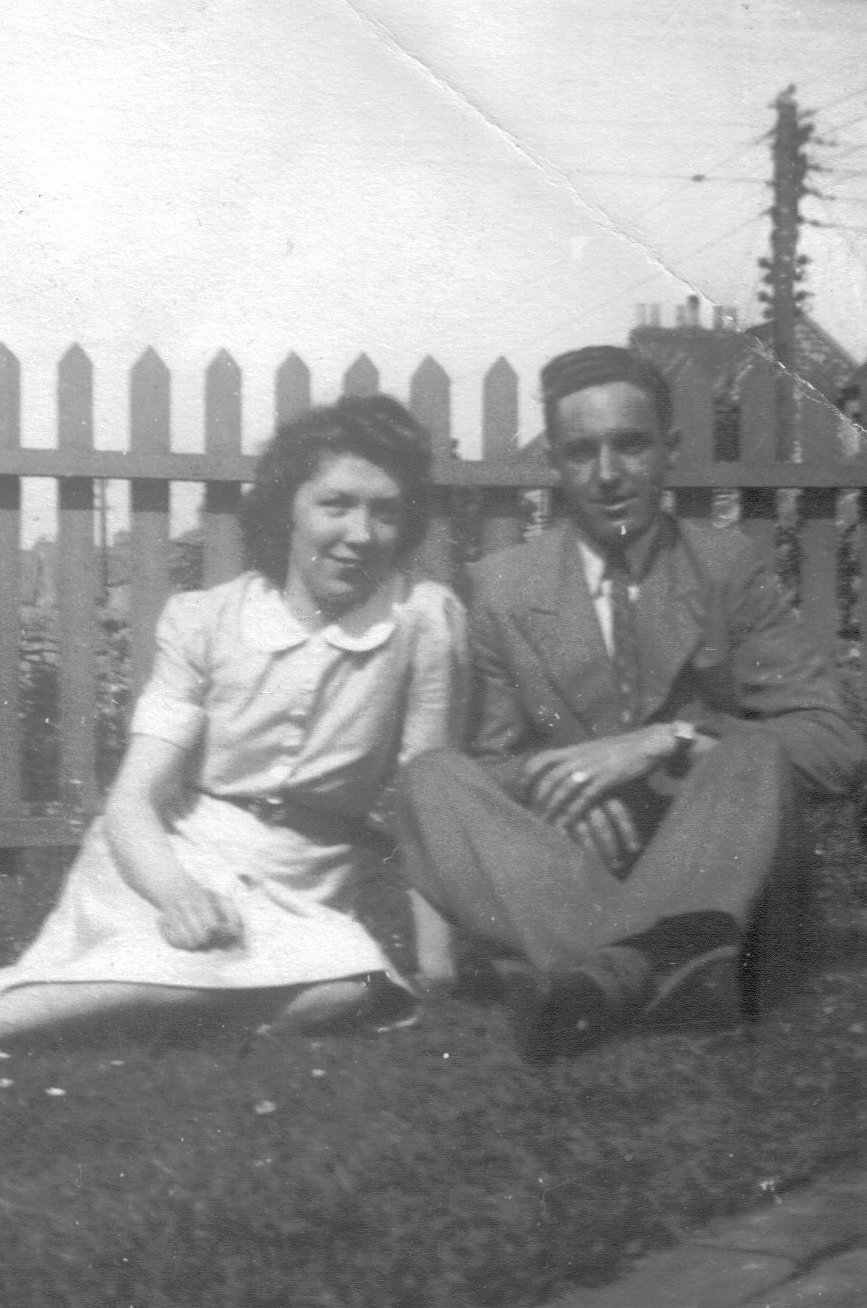
SUTTON BENGER
DEATH ON ACTIVE SERVICE.
Flight-Sergt. J. Parsons.
The death has occurred on active service of
Flight-Sergt. John Parsons, of Yatton, near Bristol.
Flt.-Sergt. Parsons was closely connected with Sutton
Benger, his grandparents being the late Mr. and Mrs. H.
Parsons and Mr. W. Humphries and Mrs. Humphries. He was the
elder son of Mr. and Mrs. E. Parsons, of Yatton. Mr. Parsons
has for many years been employed the G.W.E. at Temple Meads
Station, and he was until he joined the R.A.F. in the
Clerical Dept, of the Company, as was also the young lady
whom he married during last year—Miss Close, of Keynsham.
The funeral was at Keynsham on Tuesday afternoon, service
being held the Chapel, conducted the Minister, Rev. E. F.
Clutterbuck. It was a full military funeral, the coffin
being covered with the Union Jack, and the bearers were
three sergeants and three corporals of his own squadron
under Sqdn.-Leader R. Hope, who had been on many operations
with Flt.-Sergt. Parsons. The hymns sung were "O Heavenly
Love Abiding and “Abide with me.” The chief mourners were
Mr. and Mrs. Parsons, parents; Mr. Brian Parsons, brother;
Mrs. Humphries, grandmother ; Miss Parsons, Mrs. Clarke and
Mrs. Gough, aunts ; Mr. and Mrs. Close, father-in-law and
mother-in-law, and many other relatives and friends. Mrs.
Parsons, the widow, was unable to attend. There were many
beautiful floral tributes, including one from the Squadron,
also from the Fire-watchers and First Aid Department and the
Clerical Department of the G.W.R. The G.W.R. was represented
at the funeral Mr. May and Mr. Davis.
This photo shows John and Peggy on the day of their wedding:
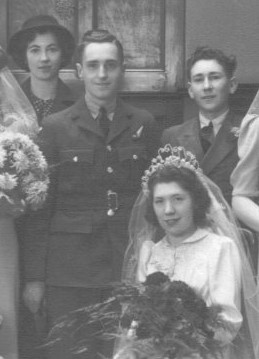
Sgt Frederick Tom COPP 614970 +
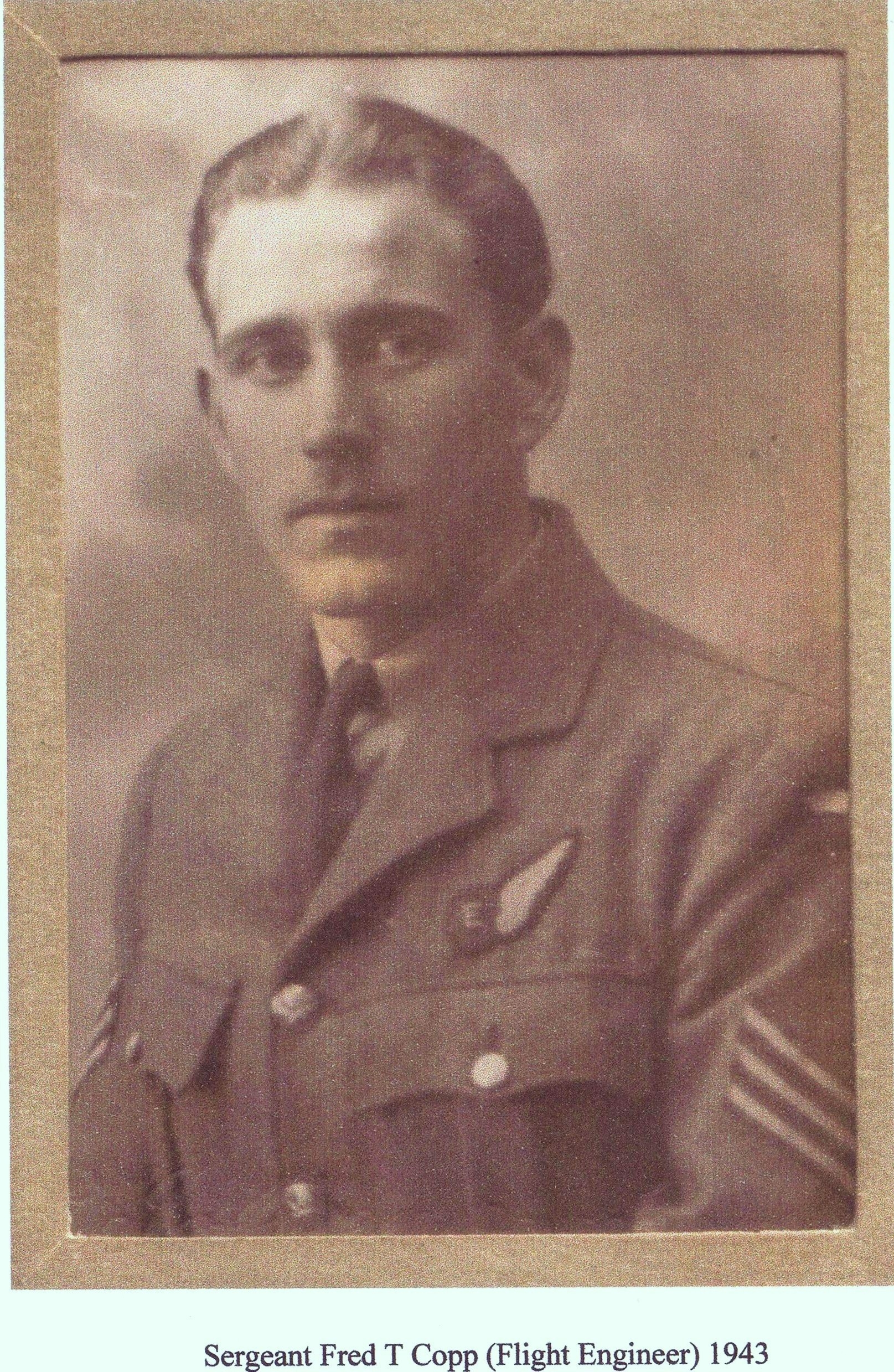 Son of
George and Rose Ellen Copp of Starcross Devon.
Son of
George and Rose Ellen Copp of Starcross Devon.
He is buried at Irvinestown Church of Ireland Churchyard.
Relatives of Fred provided the following biography of his
life:
To give you a brief outline of Fred's
history he was born on 26 Sept 1919 in a village near Exeter
in Devon. He was one of eleven children and the second
youngest of eight brothers. On leaving school he
trained as a carpenter and after finishing his
apprenticeship in June 1938 he enlisted into the RAF on 5
July 1938 to train as an Aircraft Rigger - this involved the
repair and maintenance of aircraft structures.
On completion of 'Rigger' training he was posted to 204
(Flying Boat) Squadron at RAF Mountbatten in Plymouth,
Devon, where he worked on the Mk I Sunderland Flying Boats.
He initially flew with 204 Sqn from 1 Oct 1939 to 1 Jan 1940
- as an AC I Rigger/ Air Gunner. Promoted to Leading
Aircraftsman (LAC) in March 1940 he moved with 204 Sqn to
Sullom Voe in April and in May was temporarily promoted to
Sergeant as an Airgunner. Subsequently reverting to
groundcrew duties in Aug 1940 he re-mustered to 'Fitter IIA'
and spent sometime on 86 Maintenance Unit where he was
promoted to Corporal. Re-mustering to Flight Engineer
in August 1942, Fred completed part of his formal
aircrew training at 4(C)OTU - along with Jim Gilchrist - and
on 17 July 1943 joined 228 Sqn at Pembroke Dock as a 'Flight
Engineer'.
Fred flew a number of convoy-escort and U-boat search
missions with 204 Sqn and with Sgt Jim Gilchrist and Sgt
Cyril Robson Greenwood completed 20 missions with 228
Sqn. This included the rescue of the downed RCAF crew
on 9 Sep 1943 for which F/Lt HC Armstrong was awarded the
DFC. F/O MV Wareing, F/O J Trull, Sgt J Parsons and
F/Sgt J Richardson also took part in this event.
Fred's papers show that he was promoted to F/Sgt on 31 Jan
1944 - but this is not recorded on his head stone.
For his service Fred was awarded the 1939-45 Star, The
Atlantic Star, 1939-45 Defence medal and the 1939-45 War
Medal.
I am not 100% sure why Fred was not brought home to Devon
but I understand (from my mother) that while my great
grandparents were heartbroken by the loss of their youngest
(but one) son, my great grandfather, George Copp, being an
old soldier from the Boer and First World War, felt that it
was right for a soldier to be laid where he fell.
Fred's name is on the village memorial and I have certainly
made my children aware of the sacrifice that he and many
others made.
He goes on to state
By chance I had, within the last few
weeks, been trying to find his address (Jim
Gilchrists) amongst my notes etc, as my mother
recently uncovered a group-photograph of Fred + others
(unfortunately no names recorded), at the Operational
Training Unit (OTU) in Mar 1943. Jim had told me that
he and "Freddie" were very good friends, having initially
met at the OTU . He said they had shared accommodation
in the Sergeants Mess, used to socialise together and how
they both went on to join 228 Sqn at Pembroke Dock.
From official records I know that Jim and Fred crewed
together for 20 Operational sorties - the 20th very sadly,
being their last.
The Devon and
Exeter Gazette of Februry 18th 1944 published the following
notice upon Freds' death
Broadclyst Man Killed
Sergt. Fred T. Copp, R.A.F., was killed on the night of
January 31st when the 'plane in which he was flight engineer
crashed in Northern Ireland while returning from
anti-submarine patrol.
Fred was a very popular member of a big family at 4.
Heath Hill, Broadclyst. There have been Copps in Broadclyst
for over 300 years, and the present family strongly
represented in H.M. Forces. Two of Fred's brothers are in
the R.A.F.. another is a R.S.M. in the Coldstreams, a fourth
is a sergeant in the Grenadiers, and fifth a private serving
with the Duke of Wellingtons. In addition, two brothers are
employed, one on munitions and the other on Government work.
A sister is serving with the W.R.N.S.
Mr. George Copp, the father of this patriotic family,
saw active service with the Royal Artillery during the
occupation of Crete in 1897, and again in the Boer War,
subsequently fighting throughout four years in the first
world war.
Fred was employed by Messrs. Sleeman and Sons, but left
to join the R.A.F in July, 1938, at the age of 18. He is
buried at a R.A.F. station in Northern Ireland.
Sgt 'Jim' James Kenneth GILCHRIST 1338328
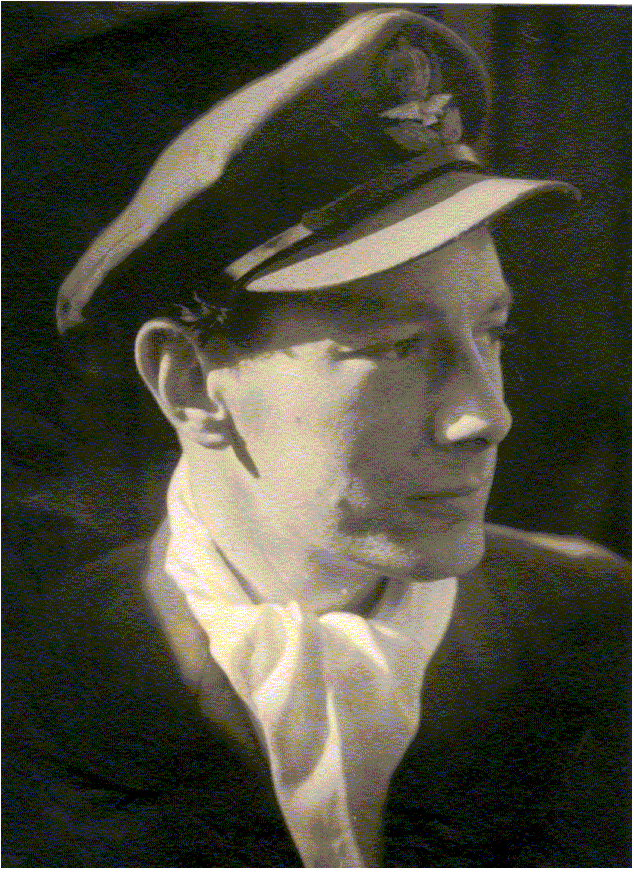 James was the son of
James and Ivy Gilchrist, of Kingsbury, Middelsex and was born in
early 1923.
James was the son of
James and Ivy Gilchrist, of Kingsbury, Middelsex and was born in
early 1923.
His younger brother, Private Neil Gilchrist, of the General
Service Corps, passed away in Cheshire on the 2nd of April 1944.
Jim provided the following recollection of the crash in a
letter to Liam briody in 1996 and it is copied here from Liam's
book, linked above:
"I found myself lying on my back
on the maintain with explosions and fire all around. I
don't know how long I had been lying there but it was
raining quite hard and my face and clothes were very
wet. I don't know how I came out of the aricraft but I
was lucky to have only wounds to the head and hands. I
was still in my leather flying jacket and flying boots but
both my leather flying helmet and gloves were missing, which
wouldn't have been the case had everything been normal.
I was a bit confused but it soon dawned on me what had
happened. I was able to get to my feet but couldn't
get near the aircraft because of the fire. I called
out, and from the darkness some distance away (but could not
see) came the voice of Gowens asking if I was from the
crash. He asked if I was injured and told me to remain
in position and that he would come towards me. Gowens had
been in the upper turret at the time of the crash and was
conscious throughout the impact luckily suffering nothing
worse than slight bruising and a nicked ankle as he
evacuated the turret and tumbled to the ground. Considering
that his turret was almost central above the bomb bay, with
explosions and fire all around him, his escape was a
miracle.
I asked what had happened and whether he knew the fate of
the other crew members. He told me that he had been as near
to the aircraft as possible and that there was no sign of
life. He was able to say that he could see bodies int
he fire but no survivors. I was feeling pretty shocked
by this time and we managed to find shelter from the wind
and rain and away from the fire by a large rock. We
decided that the only thing to do was to rest and look at
the situation at first light. I managed to find some
cigarettes (I don't smoke now) and matches and we sat
against the rock to gather our scattered wits. I still
had my Mae West, but Gowens had lost his. I was able,
therefore, to inflate mine and we both sat on it in an
attempt to keep off the wet ground. Some time later I
must have drifted off to sleep and awoke to find the dawn
casting a cold light on the mountain.
We were very stiff and my wounds were a bit painful and as
we were getting to our feet, we heard a groaning noise and
saw Tubby Richardson, the Flight Engineer, crawling around
some rocks towards us. I couldn't believe my eyes nor
my ears when he said that there were two other survivors:
Joe Trull, the Navigator and Hobbs another Flight
Engineer. Tubby confirmed that all others were
dead. I gave Tubby the signal cartridges from my Mae
West (2 Star Reds) and we told him not to move and we would
attempt to contact help. I told Tubby to fire a
cartridge if he saw anyone, as a guide to the crash site"
Jim was returned to operations on the 13th Mar 1944 and
continued patrols until posted to 4 (C) OTU in 4 January
1945. He remained in the RAF after the war, transferred to
the Air Traffic Control branch and retired as a XXX in XXX.
In a poignant twist of fate, Jim took ill on the night of
January 31st, 2008 and passed away the following day, February
1st, St. Bridgit's Day in Sussex. Many of his friends from
Ireland attended his funeral and in May of that year, his family
returned to the Blue Stack mountains to remember him and his
deceased crew mates.
Jim had become a welcome visitor to the Blue Stacks and visited
on a number of occasions. One of those he met often was
Paul Clark, a presenter from Ulster Television (UTV)
F/Sgt Arthur GOWENS 1055929
 Arthur was born in 1921
to James and Eliza Gowens. He and Jim Gilchrist went down
the mountain to get help. He went back to active service with
the RAF until the end of the War. His son understood that
he had been involved in a ditching some time before the crash of
DW110 and later on in his wartime duties an aircraft he was on
was forced to land on a golf course near RAF Squires Gate.
Details of these are not yet known but it seems likely that the
stories are mixed up as Botha L6321 of No 3 School of General
Reconnaissance crash landed on 31 October 1941 near Squires Gate
with a Sgt A Gowens on board. Arthur appears in the 228
Squadron ORB as early as June 1943, flying with variety of
crews. The flight of DW110 on 31st January 1944, was his
first time to fly with F/Lt Armstrong.
Arthur was born in 1921
to James and Eliza Gowens. He and Jim Gilchrist went down
the mountain to get help. He went back to active service with
the RAF until the end of the War. His son understood that
he had been involved in a ditching some time before the crash of
DW110 and later on in his wartime duties an aircraft he was on
was forced to land on a golf course near RAF Squires Gate.
Details of these are not yet known but it seems likely that the
stories are mixed up as Botha L6321 of No 3 School of General
Reconnaissance crash landed on 31 October 1941 near Squires Gate
with a Sgt A Gowens on board. Arthur appears in the 228
Squadron ORB as early as June 1943, flying with variety of
crews. The flight of DW110 on 31st January 1944, was his
first time to fly with F/Lt Armstrong.
He died aged 54 on
3rd December 1975 in Leatherhead in Surrey where he had
lived since 1950. He was a Civil Servant working in
the Department of Education and Science in London when he
died.
His son was able to
visit Donegal in June 2009 and visited the crash site.
The men were recorded on Air Ministry Casualty Communique No.
369 published among other places in Flight magazine, dated
13th April 1944.
The dead are all listed as Killed in Action, with the exception
of Cyril Greenwood who was categorised as "Died of wounds or
injuries received in action.". The names of Act. Sgt C S
Hobbs, W/O J B Richardson and F/O Trull were all listed as
"Wounded or injured in action", leaving just Gowens and
Gilchrist not listed indicating that their wounds must have been
considered lighter.
Following on from the Form 765 mentioned further up this
article, the RAF held a court of inquiry between the 4th and
12th of February 1944. The conclusions of the inquiry
were:
(a) Brief description of the accident and its attendant
circumstances
(b) Diagnosis of cause or causes including all contributory
factors
(c) Recommendations, if called for by the convening authority.
(a) Sunderland aircraft DW.110
captained by F/Lt Armstrong was airborne from Pembroke Dock
on 31st January 1944 at 1042 on a special A/S Patrol. At
1812 a signal was received to land at Castle Archdale on
completion of sortie. Good navigation brought them just off
Donegal Bay. A Third Class fix had confirmed their
approximate D.R. position which was further confirmed by a
range from the Castle Archdale it's S.E. Beacon. From this
point the captain decided to continue on the same course
which he did for a further 13 minutes before turning to
starboard and holding on the beacon. The aircraft climbed to
a reading of 2600 feet on the navigators altimeter. This
altimeter had not been checked with the pilots altimeter at
this time. The captain had asked and had been given the
highest land in the vicinity as being 2500 feet. The
aircraft flew on a course of approximately 140 deg compass
and crashed into a mountain 2219 ft high about 200 feet
below the summit in Cloud. Seven members including the
captain of the aircraft were killed and the remainder were
seriously and slightly injured the aircraft caught fire and
became a total wreck.
(b) The primary cause of the accident was (1) to the
failure of the captain to allow sufficient margin to clear
the highest land on the route. (2) The failure to
obtain a Q.F.E. particularly after so long a flight. the
captain F/Lt Armstrong was careless and overconfident and
must be held to be guilty of culpable negligence.
Contributory causes of the accident were (1) the Failure of
the Navigator and the apparent failure of the captain to
consult topographical maps of the Lough Erne area. (2)
The Navigator should not have been satisfied to allow his
captain to fly at an altimeter reading of 2600 feet whether
a Q.F.E. was obtained or not.
(c) It is strongly recommended that after the normal long
sorties of these aircraft particularly when landing at night
barometric pressure should be obtained at about 100 miles
from base.
Remarks
Attention is drawn to the fact that the Navigator
stopped plotting when the captain took over at 2308 when
still 70 miles from base. The spot heights shown on the
1.1,000,000 plotting chart NW 48/18do not appear in all
cases to be the highest point of land in the area. For
example: A spot height given in posn. as 54 44 N 07 57 as
547 meters (1794.16 feet)) is within 5 miles of the crash
where the sopt [sic] height is 2219 feet as shown on
the 1 inch to 1 mile sheet. 311.
Evidence shows that on this particular night there was
a large variation in Barometric pressure.
The site of the crash was marked by locals for many years,
originally with a painted memorial on nearby rocks.
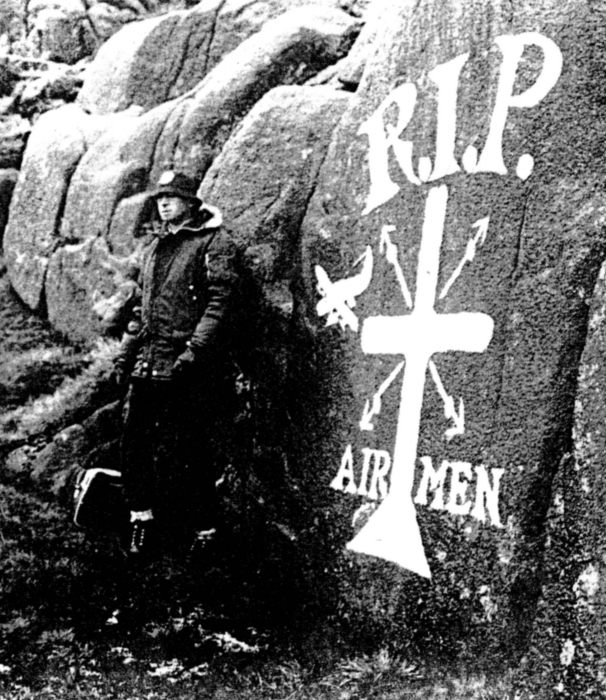
This was supplanted in 1988 by a metal plaque put in place by
Gary Pentland and a group of assistants.
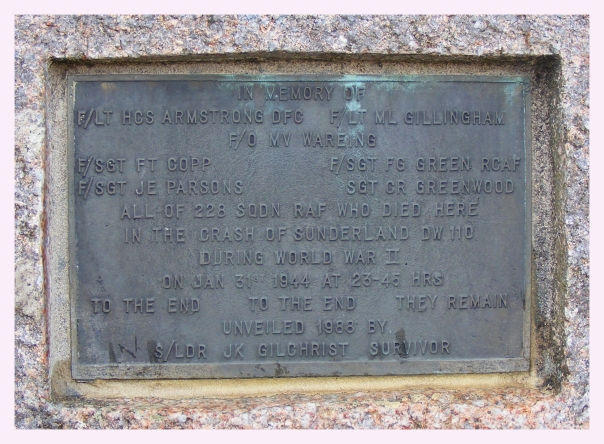
Events in May 2008.
The following is a report I prepared on the 31st May 2008 and
sent to the families of relatives not present on the day.
The local organizers will be documenting the events in due course but here is my little report. The group met at the car park at Killymard church after 10:00am. A convoy of vehicles set off then shortly before 11am for a parking area above Lough Eske. I'm not sure of the numbers but there was I think over 60 walkers in the group today including the 5 daughters and sons of Jim Gilchrist as well as two of his nephews and nieces. Also with the group were a number of Blue Stacks Ramblers members who expertly guided the group over what was a very interesting climb. There were young and old among the walkers. The UTV reporter, Paul Clarke accompanied the group all the way and the walk was filmed for UTV programming.
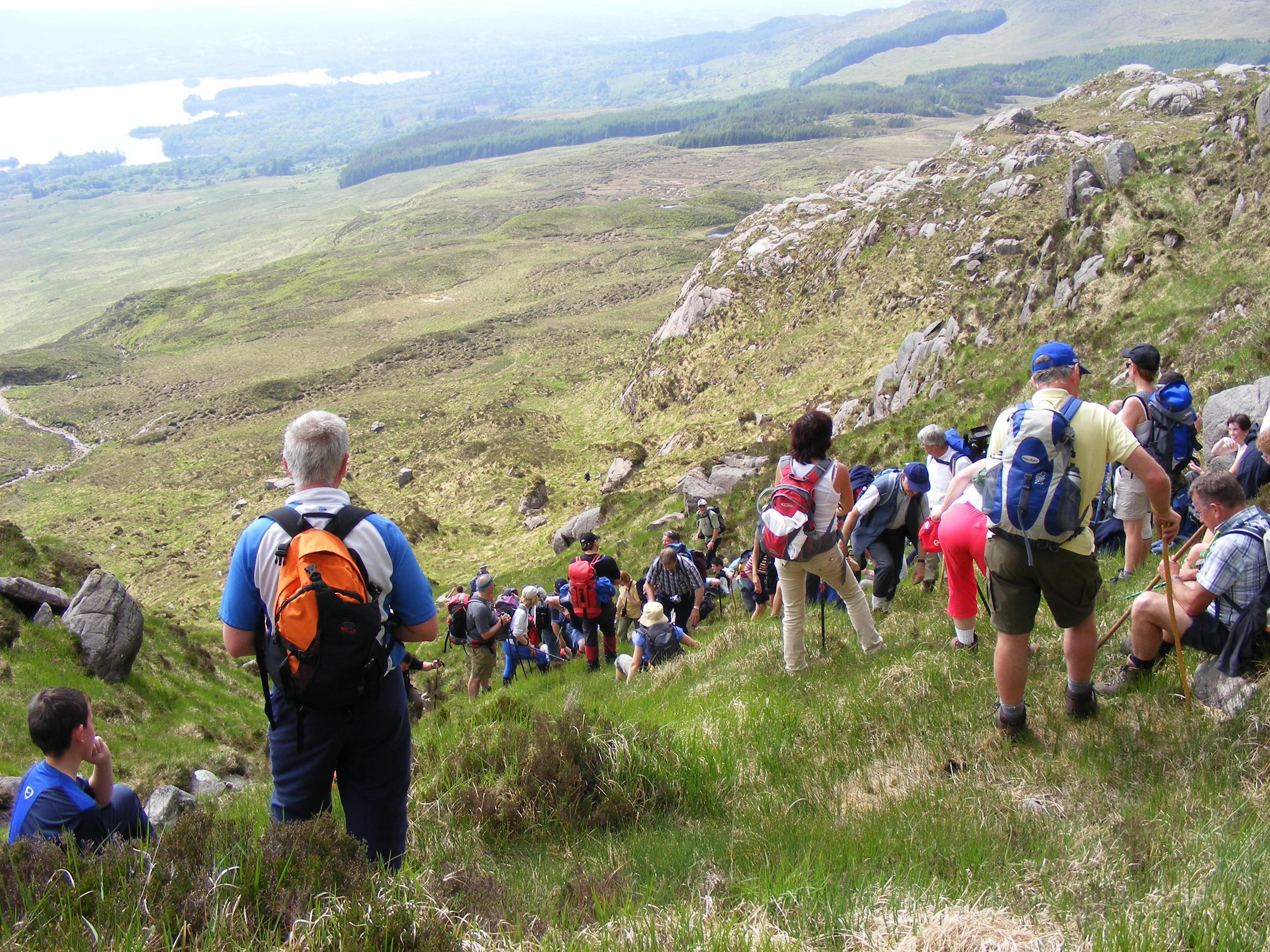
The weather played its part by
being superbly sunny and bright, perhaps a little too hot
for the task at hand, I was glad I brought my additional
water with
me. We were guided up the mountain side by the
ramblers to the rocky top of the hill. Just before
reaching the crash site everyone had their lunch and
thereafter we moved on down to the crash site.
The crash site still contains many parts from the aircraft,
small riveted assembles, some forgings and a
number of exploded machine gun rounds were found.
After all these years it is surprising how much still exists
at the site.
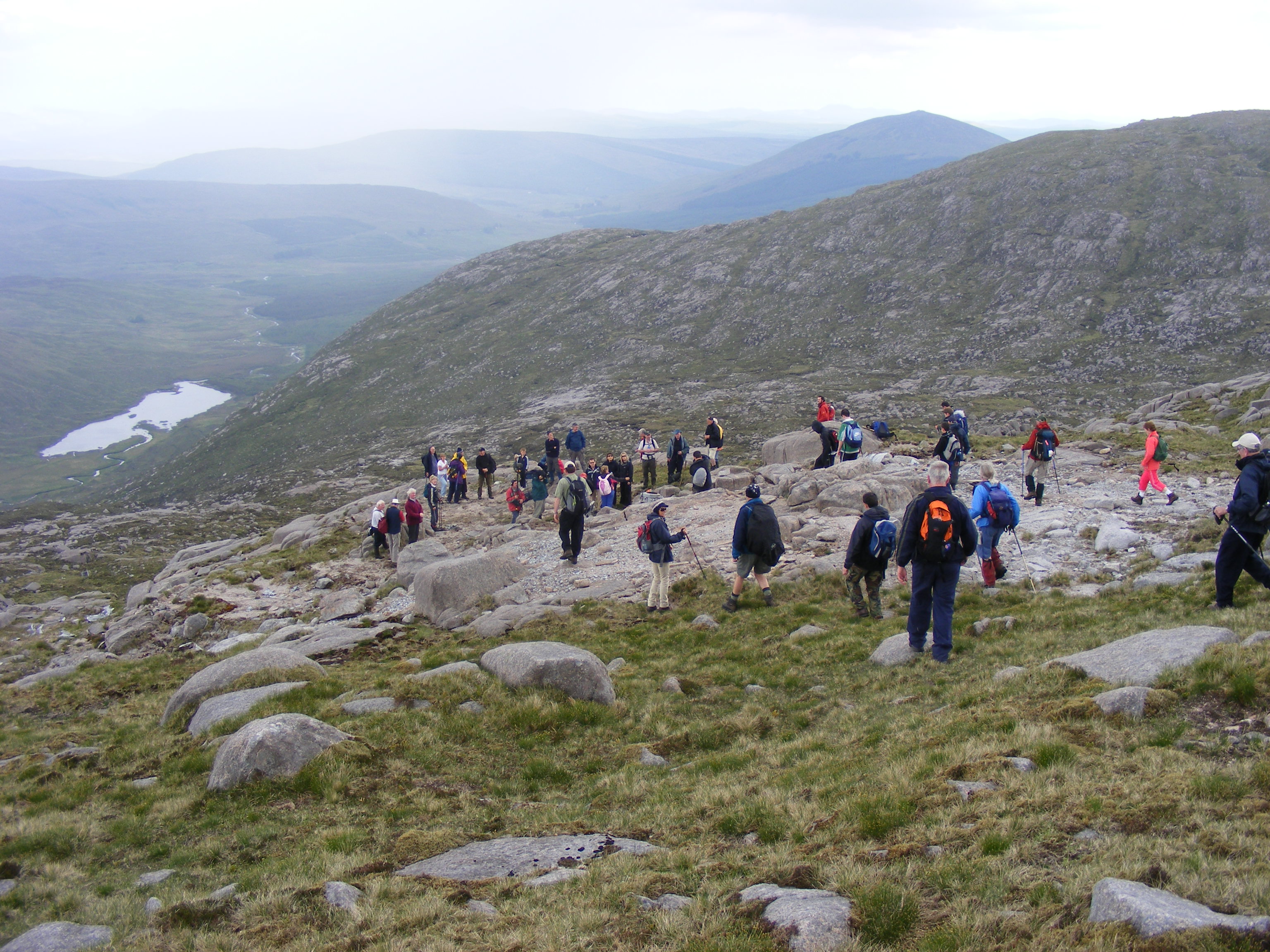
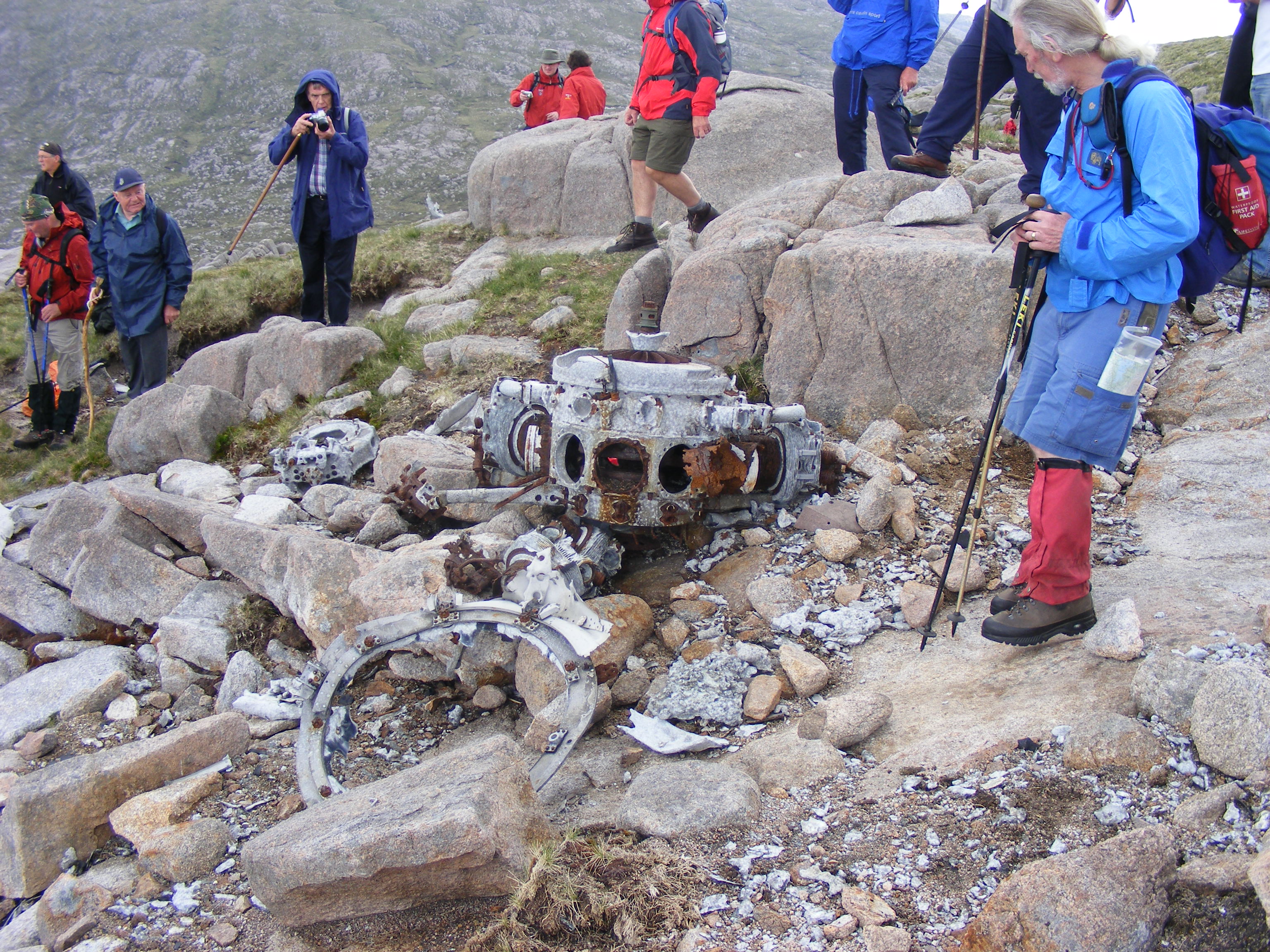
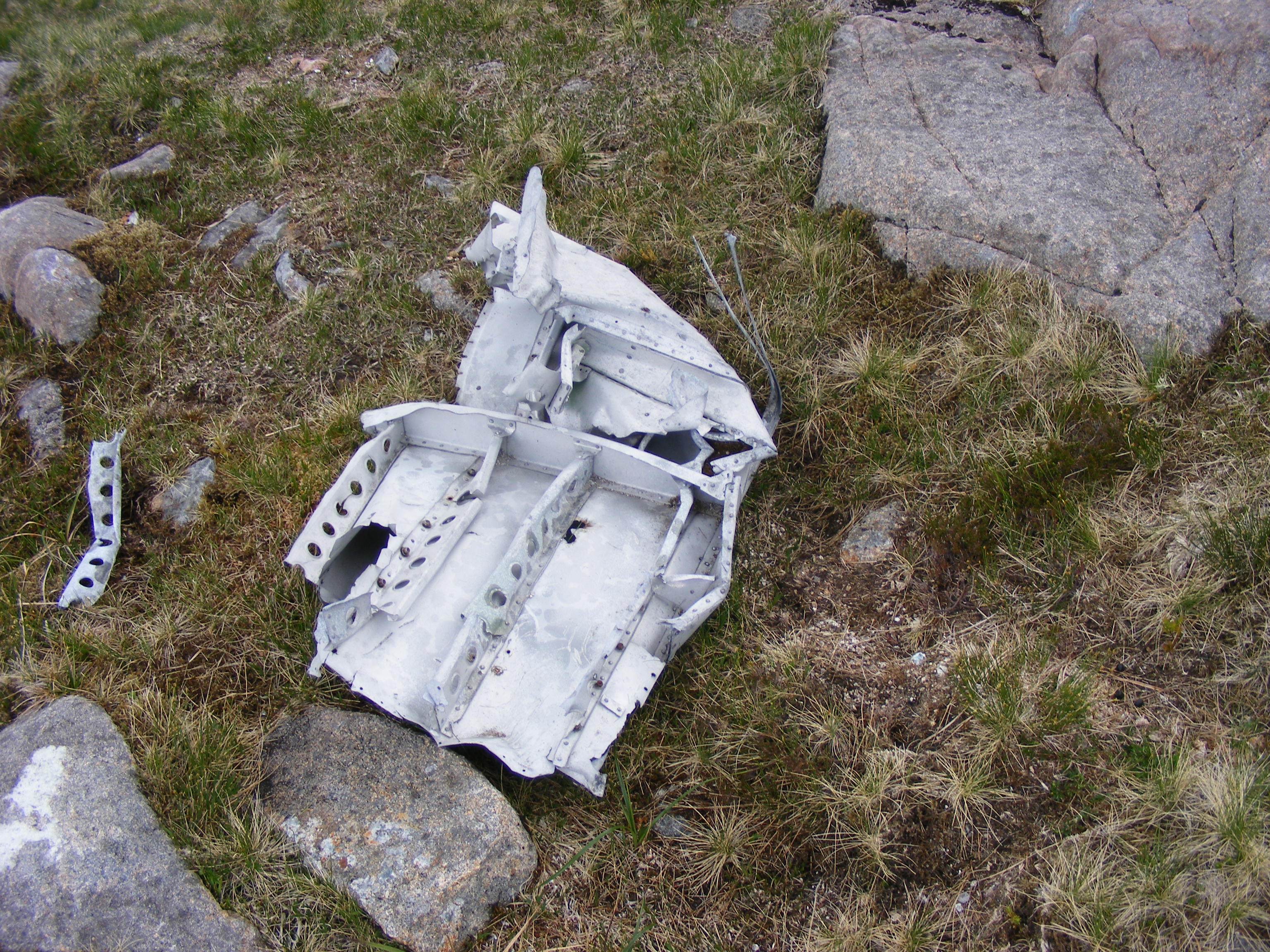

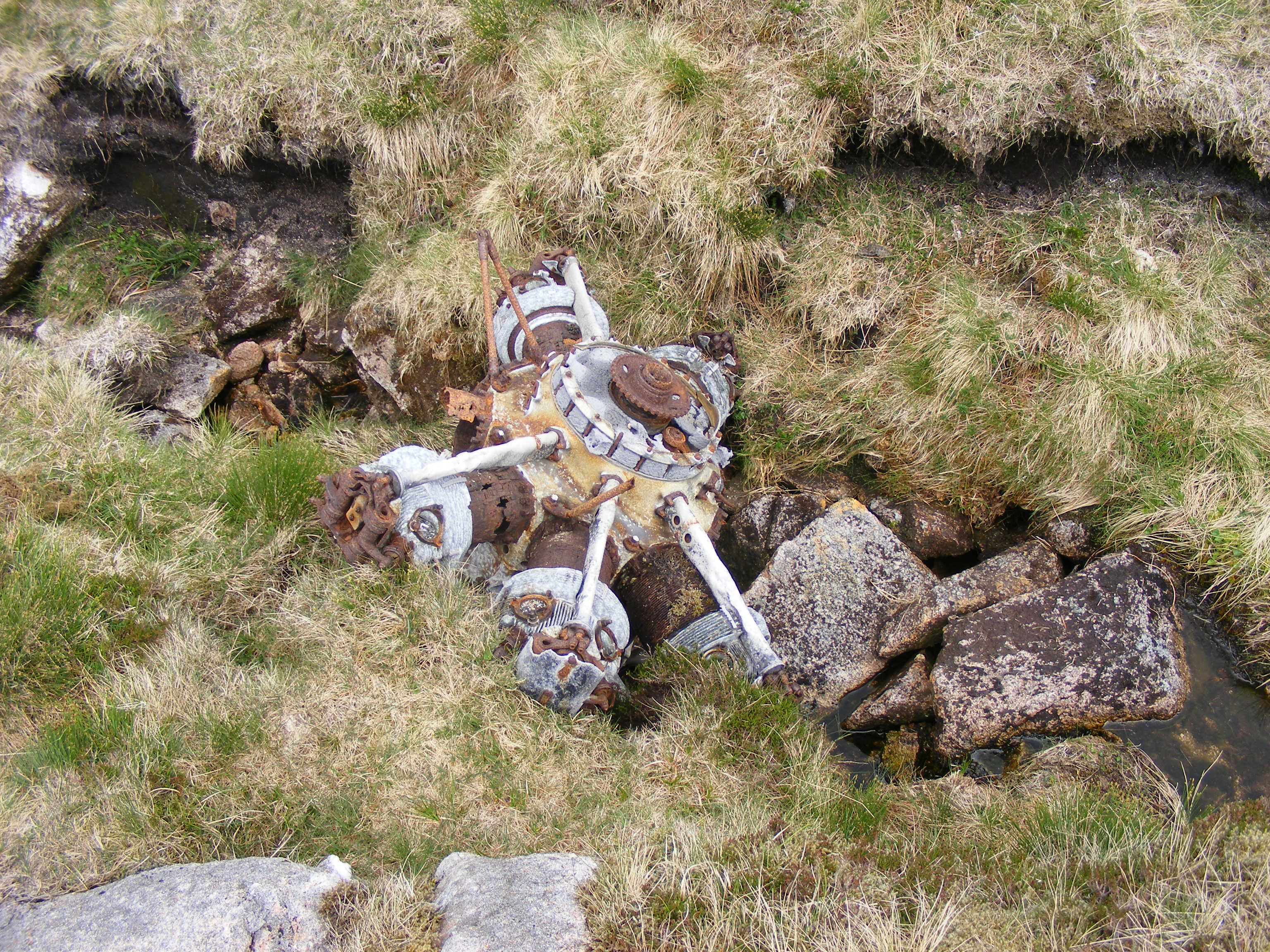
After a few moments everyone moved
down to the site of the plaque which was installed onto the
rock face some years ago.
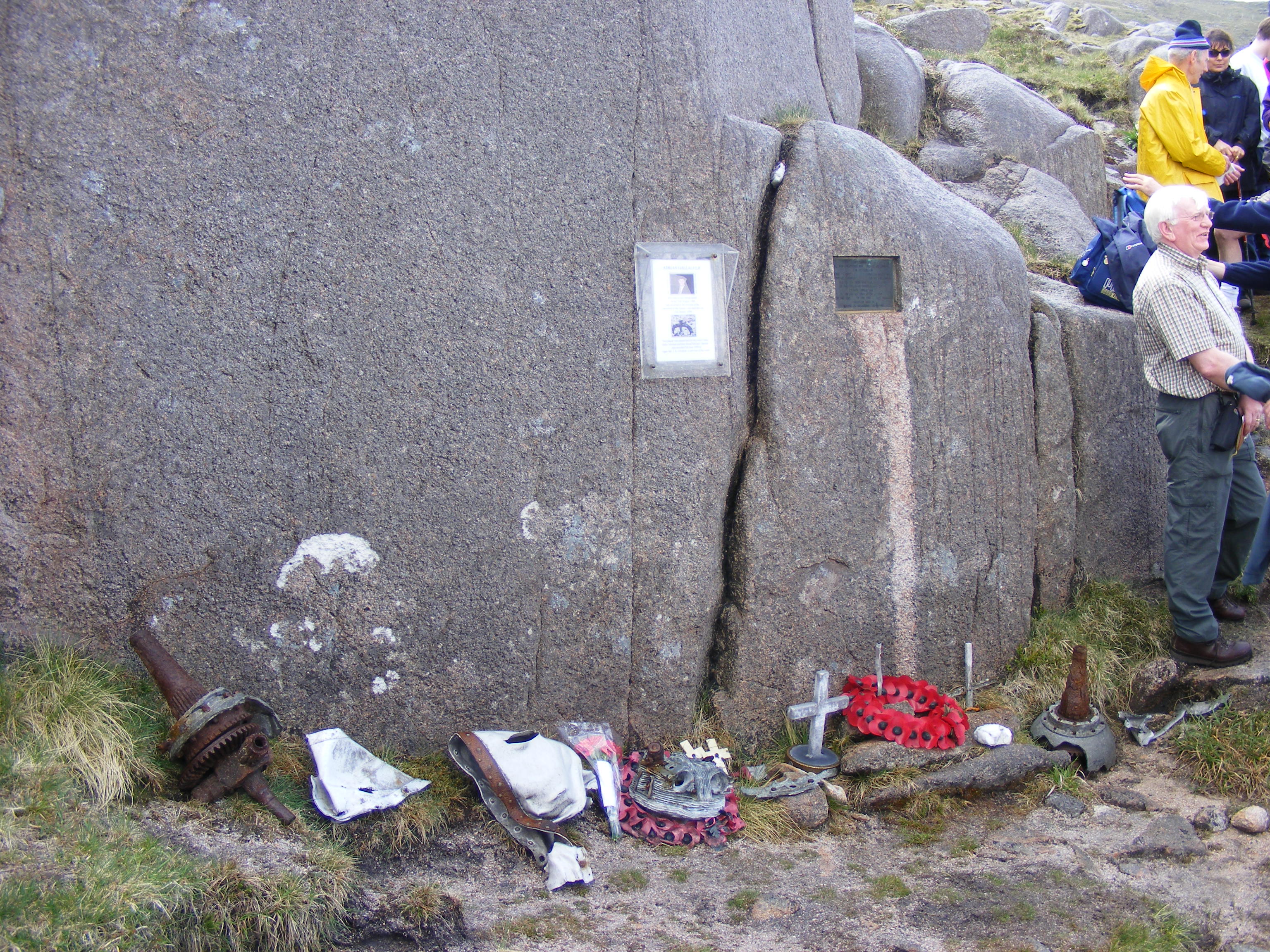
There the main ceremony began, and I may have mixed up the running
order. Two members of the local clergy began the
ceremony with some opening prayers. The five members
of the Gilchrist family then laid a wreath at
the base of the rock and each of them then said a few words
to commemorate their father. Other speakers included
Liam Briody, one time local Garda (Policeman)
who helped arrange some of the earliest memorials at the
site. He spoke for a moment then read out a detailed
poem about the history of the crash.
Paul Clarke then read out your poem Dyan and while he was
able to compose himself, I actually had to move aside myself
for a moment to gather my thoughts, having swapped
emails with you for the last few weeks. One of the
Blue Stacks Ramblers members then read two poems commemorating
the fallen airmen. Martin Gallagher then spoke for a
few moments about his memories of meeting with Jim on his
visits. Martin's son Adrian was killed the
1998 Omagh bombing and is also remembered with a name plaque
at the site. Martin had been part of the team which
installed the plaque. I was then asked to say a few
short words about those of you whom we have found in the
last few weeks. Having not prepared anything I simply
mentioned that each of you had passed on your
sincere thanks to the local people for their efforts over
the years. I kept it short and sweet and since it was
a day for the Gilchrist family to remember their
father, we shall have another day sometime to recall all the
men of DW110. The clergy then finished off the
ceremony with final prayers.
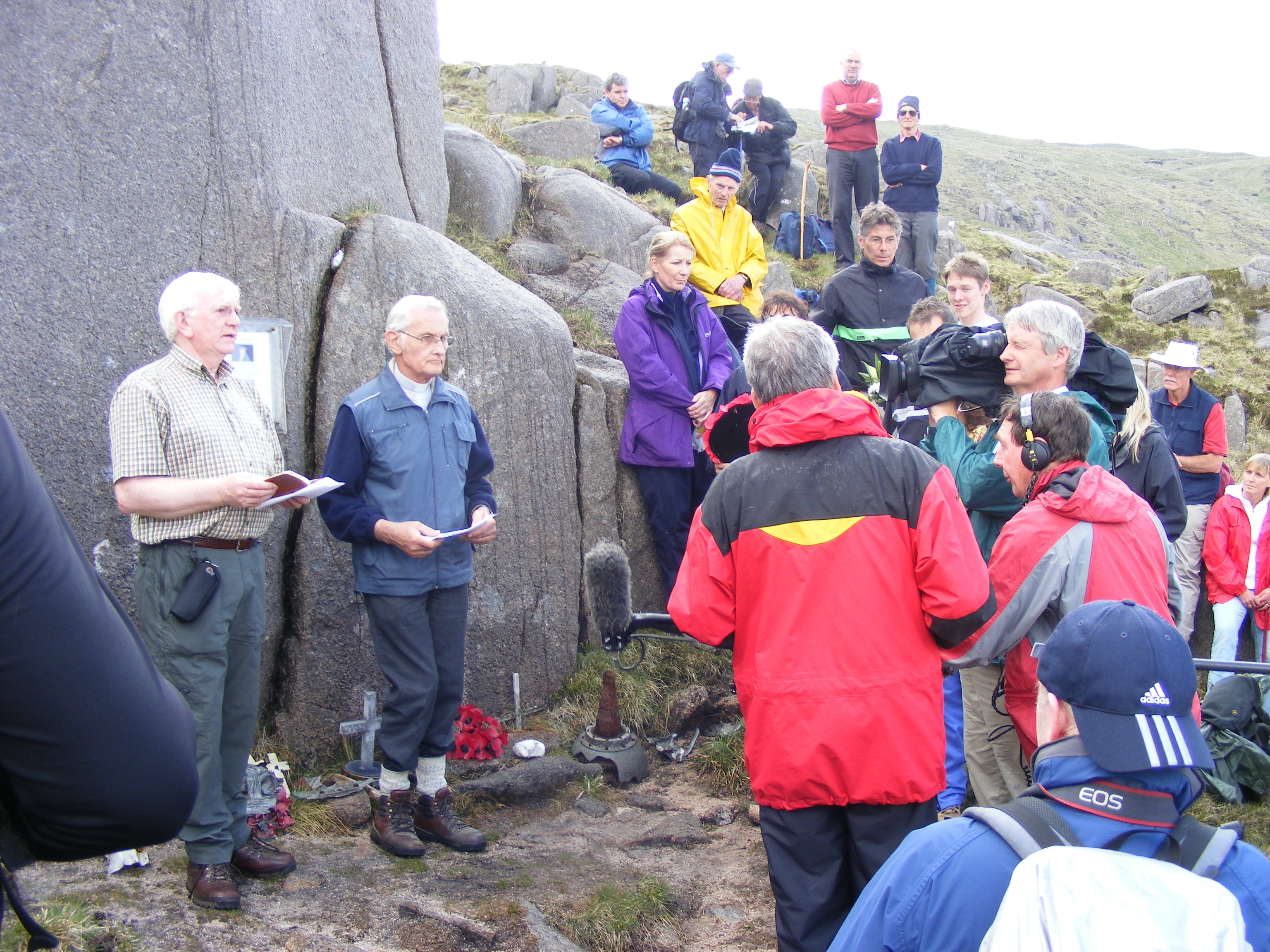
The weather had cooled down just as
we reached the site of the crash and memorial but the rain
stayed off. Following this, everyone was gathered up
and we were guided back down the mountain
again. The area of the crash is at the head of a
beautiful lake valley. As with many such crashes, had
the aircraft had those few extra feet of altitude we
probably would not have been there today. We were back
at our cars at about 4pm but I was not checking my watch properly.
Why does Nana cry?
As you come together on this special day,
My thoughts are with you from far way.
Thanks go to all for remembering the crew,
Who into this mountain in bad weather flew.
The Crew came from countrywide and over the Atlantic
too
They were the ones Churchill called “those brave few”
They were from two two eight squadron, Coastal Command,
That kept us safe, as they flew over sea and land.
Some rest now in foreign fields, others in their
homeland
But they will always be known as the crew of THE
Sunder-land
Their families will always be grateful to one and all,
Who remember their men folk here on the Mountain in
Donegal.
From my family came Flying Officer Vince Wareing,
He was dark and handsome and oh so caring.
His picture sat on the dresser, in a frame.
The family waited for him to come back, but he never
came.
When the news came in forty four,
All there was, was a knock at the door.
Grandpa gasped and Nana cried,
All we knew was that Vince had died.
I never knew, where or how or when,
But I was only very little then.
Vince was young, just twenty eight,
Grandpa, Uncle, and Dad lost their best mate.
His family never got over the shock,
They never knew about the plaque in the rock
I often watched my Nan look to the sky,
And wondered, Why does my Nana cry?
Now the crew is finally complete,
Jim Gilchrist has taken the last seat.
The engines start up and all systems are go,
For the very last mission of DW one one oh
The radio crackles and a voice is heard, “DW110 calling
Heavens Gate
Permission to land sir, sorry we’re late.”
Let us thank god that they lived, not that they died
For now I know, why my Nana cried.
They shall grow not old, as we that are left grow
old:
Age shall not weary them, nor the years
condemn
At the going down of the sun and in the
morning
We will remember them.
From “Ode to the Fallen” by Laurence
Binyon
Dedicated to the Crew of Sunderland DW110
and my Nana, Hannah Ann Kelly, Vince’s godmother.
Dyan Tucker
Paeroa New Zealand.

Compiled by Dennis Burke, 2025. This page was created to
replace a great website created by Dyan Tucker, New Zealand as a
memorial for her cousin Maurice V WAREING and his crew
mates. Relatives of almost all crew members were contacted
during the period 2008 - 2025.
